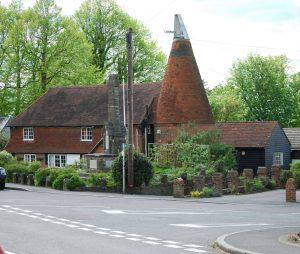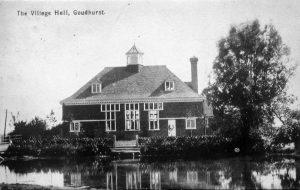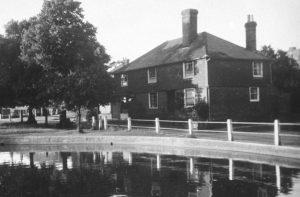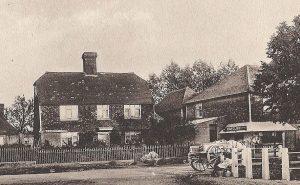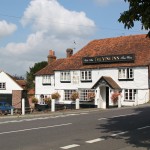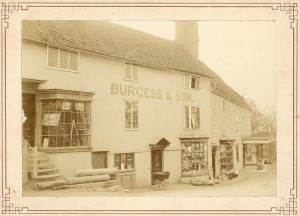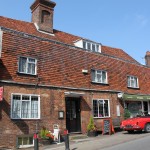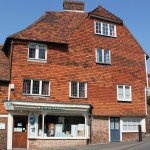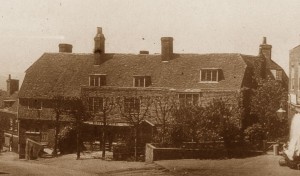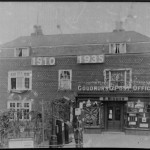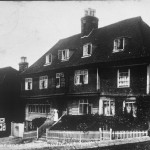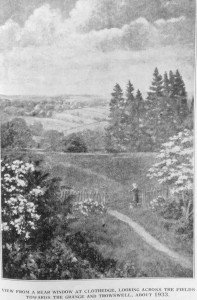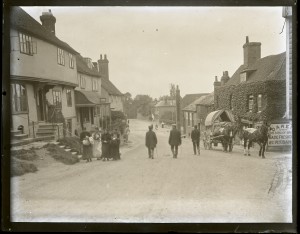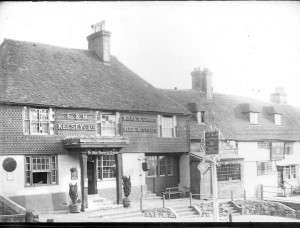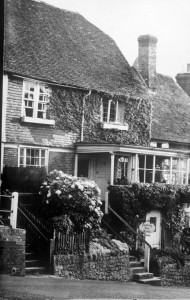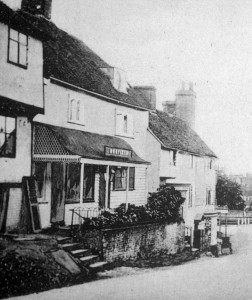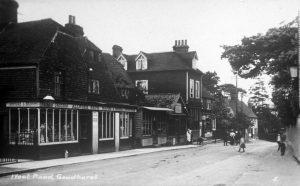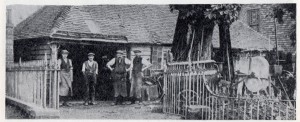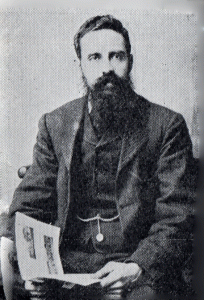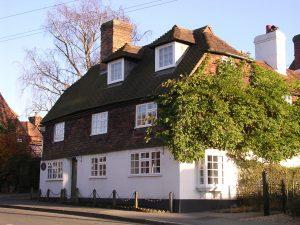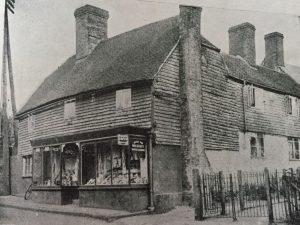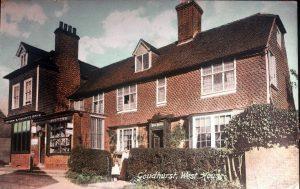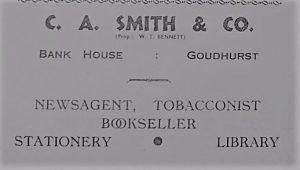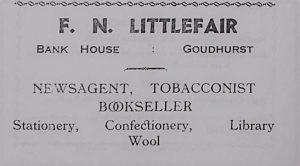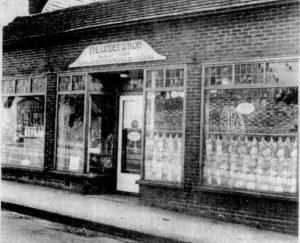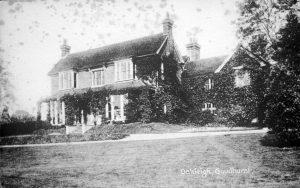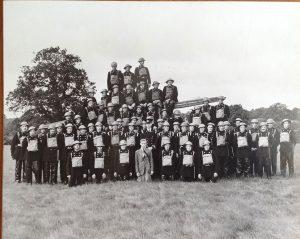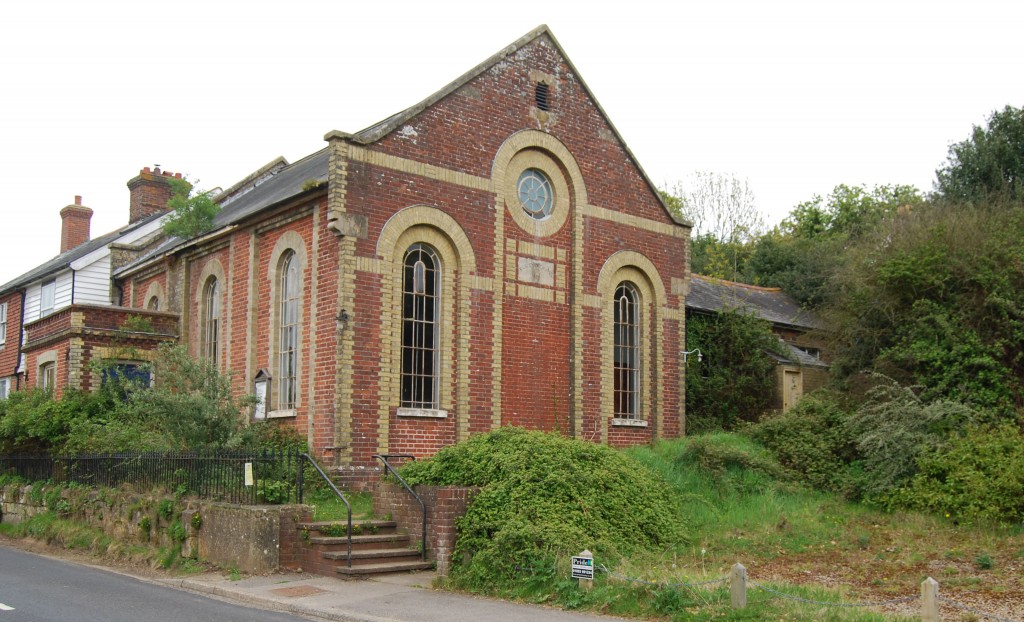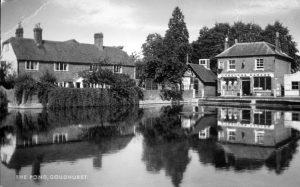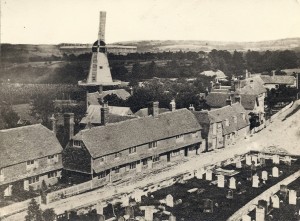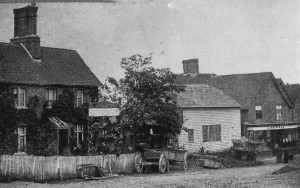Hover over the map to reveal its secrets!
St Marys Church Goudhurst

The earliest record of St Mary’s Church, Goudhurst, is dated 1119 in the reign of Henry 1. There was probably a church on the hill above the village long before then, perhaps even in Saxon times. From the present tower it is said that you can see (on a clear day, and presumably with a telescope!) an many as fifty-one other churches, from Lympne by the marshes to Ide Hill on the North Downs. Formerly this prospect would have been ever more remarkable, for when the tower was built in the early part of the 14th century it was one storey higher and crowned with a spire.
The spire stood until 1637 when, during a summer storm it was struck by lightning and burned to destruction. To the North-West, Canary Wharf Tower in London can now be seen, a distance of forty miles.
Before the Reformation a rood screen and loft spanned the east end of the nave and side aisles. It was removed some time about 1560. Parts of it were used to make the screens of the two side chapels. A door in the north aisle led to the rood-loft turret.
During the Battle of Britain in 1940 two parachute mines destroyed most of the glass in the church. A small panel of 15th century glass survives in the west window of the south aisle. The Te Deum window at the east end is a modern design replacing a memorial window that was destroyed.
The earliest church would have been a simple structure, probably on the line of the present south aisle. For hundreds of years the approach was from the south rather than the west as now, for until 1768 there was no road through the village on the line of the present High Street. The narrow Iane on the south side of the church, called Back Lane, was then the only highway.
Though the south door (still used occasionally) has a rounded arch, it is not Norman but middle 14th century. Stonework within the church survives from all periods after the 12th century. Traces of 13th century lancet windows can be seen in the walls of the Sanctuary. The colonnade dates from the early 13th century and is of limestone from Caen in Normandy. The exterior is built of Kentish ragstone.
Chief of the church’s treasures is the rare monument in painted wood to Sir Alexander Culpeper and his wife. A fine memorial to other members of the Culpeper family is to be seen in the Bedgebury Chapel. Of three ancient brasses in the chapel, the oldest dates from 1424 and commemorates John Bedgebury who went to Agincourt to fight with his king, Henry V.
St Marys Goudhurst thrives today under our current Vicar Rev. Rachael Robertson.
The Plain and Goudhurst Village Pond
This is one of Goudhurst three village greens.
In the early 1800s the village pond was known as ‘Wall Pond’ and was owned, together with surrounding fields, orchards and property, by the Church. The pond was enclosed when the new Parish Hall was built in 1903.
In around 1910, George Hinds had collected two swans, a cob and a pen, to swim on the pond. In April 1913 the cob was killed in a fight with a dog. The dog had swum too near to the swans’ nest and the male, with help from the female, was attempting to drive it away. Sadly the male was bitten by the dog and died of his wounds. A few months later, in July, a new male was obtained but the female did not take to him immediately and was frequently seen chasing him out of the pond.
In 1936 the female swan was found dead on her nest behind the war memorial. She had been well known in the village where she would calmly walk across the road and hold up the passing traffic. The male was seen to be moping and so, in July, a new female was brought in to keep him company.
In 1964 a parish meeting became quite heated when attendees were asked to decide whether there should be swans or ducks on the pond. Some thought that ducks would be better because swans strayed from the pond and caused traffic problems. Others wanted to keep the swans because they attracted visitors to the village. The votes were cast. The result: 19 for ducks and 6 for swans. The ducks had won!
In 1980 two new swans were brought to the pond but now there are just ducks. Goudhurst has always celebrated royal events in a grand way. In celebration of Queen Elizabeth’s Coronation in 1953 a model of the Houses of Parliament was floated on the pond. In June 2012 a replica model, complete with lighting, was floated on the pond and small boats were sailed across it in celebration of the Queen’s Diamond Jubilee.
Seats have been put in around the big tree and around the pond creating a favourite place for tourists and residents alike to relax or maybe to have a bite of lunch and feed the ducks with their scraps.
Goudhurst Club
In the early 1800s the oast house, barn and surrounding land was owned by Stephen Groombridge and leased to Samuel Beeching, a farmer and baker who lived in the High Street. Samuel died in 1902 and Sir Charles Jessel, of Ladham House, subsequently purchased the land where the oast house stood.
The Goudhurst Club for ‘Comrades of The Great War’ was formed in 191 and their first members’ meeting was held in 1920 in premises hired from Mr H J Benians in Back Lane. By 1924 new premises were needed and Sir Charles Jessel let the oast and barn to the club. The name of the club was changed to The Goudhurst Ex-Servicemen’s Club. Sir George died in 1928 but his son, Sir George Jessel, Bart., MC., maintained a connection with the club as its President.
In March 1929 Goudhurst Royal British Legion was formed and their monthly meetings were held in the Ex-Servicemen’s Club.
On 23 June 1938 His Royal Highness the Duke of Kent came to Goudhurst as part of his tour of Kent. During his visit he went into the Ex-Servicemen’s Club and signed their visitors’ book. He also went upstairs to meet the mothers and children of Infant Welfare Group, who regularly met there. When he left the Club he went to the Village Hall and saw an exhibition prepared by the Goudhurst Local History Society.
In 1951 the Goudhurst ‘Old People’s Club” was formed and their early meetings were held at the Ex-Servicemen’s’ Club.
On 2 June1953 a television was set up in the upstairs room at the club and many villagers gathered there to watch the televised broadcast of the Coronation of Queen Elizabeth 11.
Today the Goudhurst Club continues and hosts many social events. For more information about the Goudhurst Club see their Facebook Page.
War Memorial
PAINE’S FOLLY
In the 1840s John Paine lived in the property that is now The Pharmacy in the High Street. He was a hairdresser and barber, not a chemist, and he ran his business in one part of the shop while letting another part to a bootmaker. In the 1870s John laid claim to a small piece of land at the Plain, where the war memorial now stands, and started to build a house there to live in when he retired. The size of the plot only allowed for a very small house with one room downstairs, a bedroom upstairs reached by a ladder, and a cellar. Sadly, John died in 1879 before he retired. The name is said to have come about when a villager took a length of wood, painted ‘Paines Folly” on it and pinned it to the house, presumably in fun. The name stuck.
After his death John’s former housekeeper, Ann Pooley and her niece, Mary Ann, lived at the Folly for a short while before moving to live with Mary Ann’s parents in Ashford.
By 1881 Caroline Rhubridge was living at the Folly, Caroline was the village nurse and midwife as well as a shopkeeper selling sweets. She is said to have been a large lady weighing some eighteen stone, not ideal in such a small house. However, she stayed there until she died in 1913. Mrs Rhubridge’s sister lived there for a short while after her death.
In 1923 Sir Charles Jessel purchased Paines Folly. The house was demolished and the land given to the parish as a site for village the War Memorial. The memorial was built on the site and unveiled in 1924
Goudhurst Village Hall - Formerly Goudhurst Parish Hall
There had long been a need for a parish hall in Goudhurst and, on 1 February 1902 a public meeting was called to promote interest in a new building.
The meeting was held in the National School and was well attended. Sir Charles Jessel chaired the meeting and stated that he and other members of the community had already started to look for possible sites. He reported that, as yet, no suitable site had been secured but he was hopeful that negotiations with Mr Smart might be favourable for a site adjacent to the Plain. Sir Charles said that the estimated cost was £1100 and he announced that funds, collected and promised so far, had reached £1000.
Mr Lucas had drawn plans of the hall, and Mr Barry, of The Parsonage, had brought along a scale model of the proposed building. A Committee was set up with Edward Hussey Esq., Sir Charles Jessel, Bart., and General A Fitzhugh appointed as Trustees.
On September 6 a further meeting was held at the Vine Hotel at which Sir Charles Jessel advised that still no suitable site had been found. However, General A Fitzhugh had offered about a quarter of an acre of Wall Field Garden as a site for the hall to be purchased at a nominal sum. The offer was accepted. By this time funds had increased to £1076.
Local firm, David and Leaney, were contracted to build the new hall in 1903 at a greatly increased cost of £3000. In 1907 a large flat roofed bay extension was added on the south side, which brought more light into the hall. In 1952 a further extension was added to the southwest corner to provide a kitchen. Sarah Giles, a resident of the village, then aged 102 years, declared the new kitchen open. In 1954 the hall became a registered charity.
In 1967 a suspended ceiling was installed in the hall. Following their use of the hall as a canteen during the making of the film Grand Prix, Metro Goldwyn Mayer met half the cost. Some opening scenes of the film were shot at The Star & Eagle in the High Street.
In June 1989 the hall was declared a Grade II Listed Building. In 1966 the Committee purchased the BT behind the hall, formerly a telephone exchange building for £26,000. It is currently used as a storage room.
A contract for the refurbishment of the hall was awarded to builders, Cornfords of Brenchley, in 1996. In January 1997 work began to create a new meeting room and a storage room on the first floor, new ground floor and first floor toilets, an improved kitchen and a new stage area. The refurbished hall was officially reopened on 26 September 1998. The new meeting room was named ‘The Jessel Room’ commemorating the Jessel family’s connection with the hall and the village.
Today the parish hall is still used as a venue for village clubs and societies as well as for wedding receptions and parties.
For more information see the Village Halls Website.
Burfields House
The original house is believed to date from the 17th century but could be earlier. It stands on land that once belonged to the Church. In around 1850 Richard Springett (of Finchcocks) had a house and shop built for David Southon. David Southon set up a butchers business with his father, who had previously traded from Gazebo in the High Street, and his brother, Thomas. David also became a successful farmer and stock dealer using Bell Farm, Hammonds Farm and Four Wents Farm in the parish. When David died in 1895 his youngest son, John, carried the business on for a short time until 1901 when he moved to Halling with his wife, Florence. The house and business premises were leased to Edward Ratcliff for a term of 21 years from 25 March 1901 and the name ‘Ratcliff’s’ was displayed on the front.
John Southon died in Halling in 1904. When probate was eventually granted on his estate in 1907, the house and business was sold to Ernest Wickham. Mr Ratcliff stayed on at the property but was compelled to close down and retire when his sons and staff went off to war.
The Burfield brothers, John and William, were running a successful butcher’s business in the High Street when war broke out. William returned home safely when the war ended, having been awarded the Military Cross ‘for engagement with tanks in warfare’, and he and his brother John purchased the premises at the Plain. Together they set up a new butcher’s business there enlarging the premises and bringing it up-to-date. William ran the butchers business while John opened a fish and poultry business at his home in the High Street.
William Burfield died in 1956 and the business closed. The shop premises has since become offices and the outbuildings at the rear have been converted to residential properties.
The building today is occupied by Burfields House Asset Management
FORGE HOUSE AND THE OLD SMITHY
The 1842 tithe apportionment schedule lists the owner of a ‘cottage and garden’ on this site as the Dean and Chapter of Rochester and Samuel Hobbs is in occupation. The 1841 census confirms this and shows him as a blacksmith as was his father, Peter Hobbs.
By 1848 James Bearsby had moved to the forge from Stonecrouch, where he had worked as a blacksmith with his father. He stayed at the forge until he died in 1891.
.
In about 1889 the Ecclesiastical Commissioners had sold the property to David Southon, a local farmer and butcher. It was Mr Southon who had the wall and iron rails put up round the front garden. The rails are now grade II listed.
By 1901 (Stephen) Thomas Crouch had moved to the forge with his wife and family. Following the death of David Southon in 1895 and then his youngest son, John, in 1904, the forge and house were sold to Sir Charles Jessel for Mr Crouch so that he could stay on there. The purchase was subject to the condition that the forge was to remain unaltered. In 1908 Thomas Crouch took a seven year lease on the wheelwright’s workshop premises at Rose Villa in North Road and thus expanded his business to blacksmith, shoe smith and wheelwright. In 1931 he died at the Forge House. His wife, Mary, carried on living there until 1937 when she too died.
With the coming of motorcars the need for blacksmiths and wheelwrights declined. The house and smithy have since been become two separate dwellings, The Forge House and The Old Smithy cottage.
The Old Bank
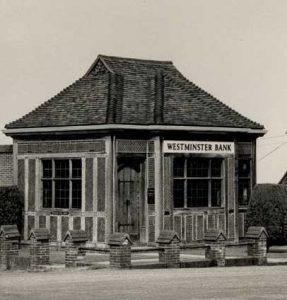 The Westminster Bank transferred its business from Bank House, West Road to the newly constructed building at the Plain in 1934. At a time when cash was the main currency the bank flourished. However, by 1996 how we handled our money had changed considerably and, despite mergers with other Banks, branches such as this were in decline. The National Westminster branch at Goudhurst finally closed its doors on 2 February 1996.
The Westminster Bank transferred its business from Bank House, West Road to the newly constructed building at the Plain in 1934. At a time when cash was the main currency the bank flourished. However, by 1996 how we handled our money had changed considerably and, despite mergers with other Banks, branches such as this were in decline. The National Westminster branch at Goudhurst finally closed its doors on 2 February 1996.
The building has been extended and renovated in recent years and is now offices.
The Vine
The Vine has stood at the bottom of the High Street, facing onto the Plain, since it was built in the early 17th century as a coaching inn. In the 18th century a coach house and stables were built on the yard along the North Road side of the inn. Then, in 1874, the Assembly Room, incorporating a dining room and a kitchen, were added at the rear. An existing room and an old cottage were demolished to make way for the new building. In the 19th century the Vine had leaded light windows but these have since been replaced.
The Vine has had many licensees over the years. The earliest we know of was Thomas Tolhurst in 1734. The 1851 census shows the licensed victualler was William Knights who lived there with his wife, Ann. By the 1861 census James Hayward kept the Vine. He held it for a good number of years and when he died there in 1873 he was buried in Goudhurst churchyard.
The 1881 census shows James Thurgood and his wife, Katherine, living there with their two young daughters, Alice, 14 and Annie, 10. Mr Henry Osborne is shown on the same census living at 4 Hunts Lane, directly behind The Vine, and employed as an Ostler.
By the 1901 census John and Jessie Barrow were there, followed in 1910 by William Voice. Finally, the 1911 census shows Andrew Grove in residence. Since then a number of licensees have come and gone, Mr Ticehurst, the Popplewells, the Denches, the Bucknells and the Wells to name but a few.
As with most of the pubs in Goudhurst, the Vine is reputed to have been involved in the smuggling trade. Another noteworthy event for The Vine is that the inaugural meeting of the Hop Marketing Board was held in its rooms in 1932.
In the 1940s Mr L B Wells was proprietor of the Vine, and in the 1950s his wife, Eileen, took over.
Today the Vine still occupies its prominent position at the bottom of the High Street where one can sit outside and watch the comings and goings in the village. Sadly the pub is closed awaiting new owners!
Burgess Stores
In 1831 William Burgess became the owner of a shop in Goudhurst which was to bear his family name from that date until 2012. Burgess married Anne Gilbert in about 1834 and it was her father and brother, both named John, who were the original owners of the business. A stock book dating from 1832 shows that the shop sold fabric and clothing, such as muslin and, serge, caps and hats, lace collars and edging, as well as some earthenware, candles, shoes and sundry items. The total value of the stock was £502.
In 1858 William’s son, William Chester Burgess, was taken in to partnership, followed by his son, Frank in 1884 and so on down the generations until the Burgess family sold the shop in 1971.
Owners: John Gilbert,. Snr; John Gilbert, jnr;
William Burgess, from 1831; William Chester Burgess; Frank Burgess; Victor Chester Burgess; Geoffrey Burgess; Charles Lucking; Mr & Mrs Gee;
Kenneth & Barbara Johnson; John & Elaine Maxwell-Jones;
New owners took over the shop in 2012 and immediately renamed it Goudhurst Village Store. It closed for a few months in 2015, before it was re-opened under new ownership in November 2015. The official re-opening took place in February 2016 when the shop once more became “Burgess Stores”.
The original shop was in the same premises as it occupies today, on the corner of the crossroads in the centre of the village. However at one time it also occupied many of the buildings next to it moving up the High Street towards the church. Originally this “top” part was leased, but on the death of the original owner, William Chester Burgess was able to purchase these additional premises in 1869.
As a grocer and draper the shop employed a number of male apprentices who wished to learn the trade. Surviving apprenticeship indentures show that this was typically a two or three year apprenticeship in which the person concerned was paid a nominal sum (or nothing at all) per week for the first year which rose in subsequent years until the apprenticeship ended.
Vine Cottage
Next to the Vine is Vine Cottage. Today it is a residential property made of two cottages combined. But, in 1851 it was a bakers and confectioners shop run by Mr Charles Osborne. In 1861 Charles was still working as a baker but now his sons, Edwin and Mark, were bakers too. However, the 1861 census shows Edwin as a dealer in fancy goods. Between them, the family occupied both parts of the property, Edwin and Mark living in one part and Charles, his wife and other children in the other.
Mark died in 1861 and Charles died in 1864 leaving Edwin in his cottage with his wife Emma. Edwin carried on the business alone although he did have some help from his brother Henry. Many folk did not have their own ovens so Edwin would bake their bread, cakes and even cook their Sunday dinners for them. Henry would often be seen going around the village with a tray balanced on his head which he used to carry the uncooked items he had collected to the bakery. On Sundays, villagers would call at the bakery on their way home from church to collect their cooked dinners. This all came to an end when Edwin sadly hanged himself in the shop in 1899.
The cottage and shop was taken over by a farm labourer, Mr Percy Gardiner, and his wife Ellen. Mrs Gardiner made and sold sweets as she had at their previous address at Ballards Hill.
In 1912 Cecil Remnant moved to Goudhurst and a few years later, in 1918, he married Amy Gardiner. Amy took over the sweet shop from her parents and sold chocolates, confectionary, tobacco, cigarettes, minerals and Lyons ice cream while Cecil ran his fishmonger’s shop on the opposite side of the High Street. Amy died on 23rd January 1948 and in her will she left effects to the value of £1988.19s 5d. Her daughter, Hilda, ran the shop for a short while after Amy’s death.
When the shop finally closed its doors, the property became solely residential. Today Vine Cottage is one residential property with two front doors, but only one door is used.
Weeks Bakery and Tea Rooms
Attached to Vine Cottage, and at the end of this range of buildings, is Weeks Bakery and Tearoom. The buildings date from the 16th century and, in the 1800s was divided into two dwellings. We know that in 1863 the property was in the hands of the Clemetson family who also owned and ran Hope Mill. We also know that it was the site of the old Methodist Chapel until 1836 when it was sold and a new chapel was built in North Road.
In 1851 the property on the left, as seen from the High Street, was occupied by Thomas Dungey, his wife Elizabeth and their two young children, also named Thomas and Elizabeth. Thomas was a miller and journeyman. Next door to Thomas lived sixty four year old Sarah Hazelden with her thirty five year old daughter, Mary. Sarah was a corn dealer.
By 1861, Charles Farley had moved into the lower cottage with his wife, Mary, and their three children. Charles was a horse dealer. The upper cottage had by now been taken over by Samuel Beeching. Samuel lived there with his wife Ann, their two children and a servant girl. He was described on the census as ‘a farmer of 20 acres employing one man and one boy‘. Ann ran a business as a corn dealer. She also sold coal which was stored in the cellar at Gazeebo across the street. When the adjoining lower cottage became available, Samuel took that over too and by 1871 he had started a bakery business there. By this time Samuel farmed 25 acres and employed two men and three boys. Samuel’s wife, Ann, died in 1884 and it appears he gave up the business soon after and moved to Manor Cottage, a little further up the High Street. In 1892 Samuel married his second wife, Ellen, who was considerably younger than him. Samuel died in 1902.
Richard Balcombe took over the business in around 1884 advertising himself as “Baker, Corndealer and Confectioner” but he didn’t stay long. In 1888 Arthur E Davidson was trading as a “Baker, Corndealer and Confectioner” here and he was the subject of some court cases for offences under the Bread Act. He didn’t stay long either and by the time of the 1891 census Arthur Hill was listed at the property and his occupation was given as a baker. Arthur was living there with two servants. By 1901 Arthur’s wife Sarah was living there with him. They had one domestic servant and one shop assistant with them. Arthur left the property in around 1907 and moved to Rainham.
When Arthur left in 1907, Mr Richard T Banks purchased the property, renaming it Banks Bakery. He lived there with his wife Minnie and their two children, Edward and Cecil, and one domestic servant. Richard had been running a bakers and confectioners business in Lewisham before coming to Goudhurst. An advertisement in the Parish Magazine in February 1917 read;-
‘Standard Bread, guaranteed the Best Government Bread in which 80 per cent. Of wheat is used. Has a most delightful nutty flavour, easily digested and assimilated. Builds up a healthy, robust constitution. If you eat it you will like it.’
Richard Banks built up a thriving baker, pastry cook and confectioner business and owned his own horse drawn delivery van.
In 1931 Mr Louis Weeks and his wife Dorothy bought the business giving it the name it is still known by today. After a few years Mrs Weeks’ brother, Bert (Albert) Brown, joined the business. Bert had been a steward on luxury liners before settling down in Goudhurst. Together they ran a very successful bakers, confectioners and outside catering business. They also later bought Mr Humphries grocery business in North Road changing the name to Weeks and Brown.
Bert Brown was responsible for many celebration cakes in the village, not least the four tier cake he baked for the village Coronation celebrations in 1953. It is said he made the baking tin for the bottom tier from a dustbin. Sadly, Dorothy died in 1970 aged 78 years and Louis died in 1974 aged 83. Bert died suddenly in December 1994 at the great age of 91 years.
In 1973 the Weeks family sold the business to Peter Smith. He was already running a successful bakers and confectioners business with shops in the local area. Peter kept the Weeks name on the Goudhurst shop. However, sales eventually took a downturn in all the company’s shops and in 1996 Peter Smith’s business went into receivership. The bakery and tearoom was saved by Dawn Tompsett in 1996. Peter died in April 2008.
Today, it is still a bakery and tearoom and the name above the door is still Weeks.
THE PHARMACY
Today this is the village pharmacy, it was not always so.
The 1841 census shows John Paine living here with his son Edward. John ran a successful hairdressing business from the cottage. After a few years he also had a bootmaker working at his shop, the two trades being divided by a screen. He continued to live and work at the cottage until he died suddenly in 1879 aged 68 years.
John Paine is known in Goudhurst as the man who built the quirky Paine’s Folly, which once stood on the site where the war memorial is today. Paine’s Folly was a very small house that John was building for his retirement. Unfortunately he never had enough money to complete the building work and never lived to reach retirement age.
The 1881 census lists James Thomas Dann at the property. He was a master bootmaker who moved to Goudhurst from Maidstone. James had worked for F W Randall & Co. – Bootmaker, the well known shoe shop still in Gabriel’s Hill, Maidstone today. James and his two sons, James and Edward, moved to a cottage in Stoney Lane in 1872 and set up a bootmaking business there. His wife had stayed in their home in Maidstone to look after the business they owned there.
When John Doust died in 1875, James bought his business at Church House. Later he also bought John Paine’s shop and that eventually became his main business premises in the village. In around 1878 James returned to Maidstone and left his eldest son, also James Thomas, to run the business in Goudhurst. James ran the shop until 1886 when, for the princely sum of £20, he sold it to Benjamin Rayner.
The 1891 census shows Benjamin Rayner, bootmaker, at the property with his wife Anne and their children. Benjamin is still on the census in 1901 and 1911. He continued to run the business until he died in January 1918 aged 68 years. It was Benjamin Rayner who had the box bay window fitted. When Benjamin died Sidney Jones took over the business for a few years.
Then came a very different business. Mr Cecil Verrall had started his pharmacy business in Goudhurst on the ground level of the Old Tavern (Church House), where the garage is now. By 1935 he had moved to the property now known as The Pharmacy. Mr Verrall also had a pharmacy business in Marden. He was pharmacist in Goudhurst until 1949.
In 1949 Robert G Rigg took over the pharmacy and stayed there for a good many years. He first appeared in the telephone directory and in the Parish magazine in 1949. The last telephone directory entry found for Mr Rigg in Goudhurst was in 1970.
Since then there have been successive occupants, but the business has remained a pharmacy and chemist shop.
Manor House
It is said that the Manor House was a school in the early 1800s. Reminiscences from a member of the Thurgood family reproduced in the Goudhurst Coronation Book say that the school was thought to have been kept by a Miss Birch. John F. Thurgood’s daughter Florence attended the school for a while. Another source says that John Allwork, brother of William Allwork, grocer and draper of Church Road, taught here. His classes were for boys only.
We can say for certain that John Francis Thurgood, a merchant clerk, his wife Anne and their children moved from Gore Farm to the Manor House in around 1864 because the farm was being sold. They are shown at the property on the 1871 census. However, by the time of the 1881 census they had moved to Trottenden and then, in 1885, they moved to Ratcliffe House in North Road.
The 1871 census also shows Thomas Francis, a professor of music, living at the Manor House with his wife Elizabeth and their two children. Mr Francis had moved to Goudhurst from Cranbrook, then by the time of the 1881 census he had returned to Cranbrook.
The 1881 census shows that George Eedes had moved in to the Manor House with his wife and five children. George was a druggist and chemist who had previously had his chemist shop at the Gazeebo in the High Street, and then in West Road. Over the years his family grew until on the 1891 census he has eight children. In 1917 George retired and moved to Groombridge.
When George retired the Manor House was occupied by a series of doctors: Dr. Collingridge, Dr. Forge and Dr. Marshall. Then, in 1931, the house was sold to Mr Frank Simmons who came from Tunbridge Wells.
Today the Manor House and Manor House Barn are two separate residential properties.
Goudhurst House
The property is believed to have been built in the 1600s and it was once the site of the old Goudhurst Poorhouse. Later, during the time of the Peninsular War, it housed military officers while the troops were billeted at The Barracks (now Church House) next door.
By 1841 John Nye was living at the property with his wife Mary, their daughter and four sons. John was a grocer and draper and employed two apprentices in his shop. He had previously had a business in Horsmonden and then moved to Goudhurst in the late 1830s. The 1851 census shows that John’s son Frederick was working in the shop too and then in 1861 Frederick and his brother Alfred were both working with their father together with an employee, William Reeve. By the time of the 1871 census Alfred had married and left home to start his own business as a gents’ outfitter in Tunbridge Wells.
John’s wife Mary died in 1878 and is buried in Goudhurst churchyard. John retired from the business in around 1879 and letters from members of his family copied in the Goudhurst Coronation Book say that they believe he moved in with his son at Church Villa for a while. The 1881 census shows John staying at his son Alfred’s house at Mount Sion in Tunbridge Wells. Alfred was now a furniture dealer and commission agent. His brother Frederick had moved to Bromley and had his own grocery business there. John Nye’s last move was to Brenchley where he died in 1883.
The 1881 census for Goudhurst shows that Albert Stephen Taylor had moved here from Marden and taken over the shop as a grocer and draper. Albert moved in with his wife Fannie and they had one apprentice lad lodging with them. Also lodging there with them was the Goudhurst Curate, Alfred Charles Highton. Alfred had studied in London before coming to Goudhurst. He returned to London before moving to Oxford in 1901. He died in Oxford in 1932. Albert Taylor did not stay in Goudhurst for very long. By 1891 he had moved to Deal where he had set up his gents’ outfitters business.
Next came James Baker. He is shown on the 1891 census at the shop as a grocer and draper with his wife Bessie, their daughter, also Bessie and aged 1, and his sister Elizabeth. Before coming to Goudhurst James had learned his trade as a draper’s apprentice in Lewes. James spent a good many years at the shop.
At this time the property was owned by William Rootes, father of William Edward (Billy) and Reginald (Reggie) Rootes, joint founders of the Rootes motor sales company. William and his family moved to Hawkhurst and, in March 1911, he sold the property to Rose Midmer. Rose was the postmistress at the post office and shop in North Road. In 1834 the property had been damaged as a result of a gunpowder explosion at a shop in North Road. Previous owners and tenants had refused to repair the shattered bay window at the front of the property because of the cost involved, so it had been boarded up for many years. Rose had the window repaired and also had the property extended at the back. By 1915 she had moved the post office business from North Road to her new shop at Goudhurst House. Her shop was advertised as selling stationary and fancy goods. Rose Midmer ran the shop and post office until she died on 27 November 1943.
The 1948 trade directory shows Mr W J Bennett had taken over the shop and post office at the property, but in later years the post office was moved from here to West Road and then in 2001 to Burgess Stores. Today, Goudhurst House is the village newsagents and is once again home to the post office.
Church House and Cottage
Church House is easily identified at the top of the High Street by its double front doors of solid oak reached by a flight of steps from the street. The adjoining cottage has its own entrance from the High Street, but in the past it was also accessed from passages on the ground floor and the first floor of the larger house.
The house has been used for many varied purposes over the years. It began life as an old Flemish Weavers’ Cloth Hall in the 15th and 16th centuries. The large room on the lower floor is said to have housed two looms.
Much later, in 1747, Church House was used as a barracks by the newly formed Goudhurst Band of Militia, notorious for its defeat of the Hawkhurst Gang under its leader, William Sturt. The barracks was still in use during the Peninsular War, 1808-1814, and the troops were said to have been drilled on the Glebe Field. The use by the military gave the house its name at the time “The Old Barracks”.
In the 1800s the upper rooms in the house were let. An old villager, Daniel Brackfield, was born in the Old Barracks in 1823 when his parents rented three rooms there.
The 1851 census shows Jarvis Lambert and his family at Church House. They were probably living in the part that is now the cottage. Little more is known about the use of Church House until 1861 when the census shows James Couchman there with his wife Ann. James was 48 years old and Ann was 77 years old. Ann is shown as the attendant at the Reading Room. Ann and James lived in the right hand part of the property, probably the cottage, and the Reading Room, or library, was the large room on the left of the house. This is the room where the looms were once housed and where the muskets of the soldiers were hung on hooks along the walls. The rest of the house was being let out as tenements with the rooms under the roof given to poorer people of the village at low rents. One person known to give readings here was Edward Smart, a farmer living at Horden Farm. When people heard that Mr Smart was on his way, the Reading Room would be packed, such was his popularity.
The 1871 census shows that John Doust, a boot and harness maker, was living at Church House with his wife Jane and their two daughters. We know from records made by Alfred Tiffin in the Goudhurst Jubilee Book that John lived in the cottage. He used the room with a window that overlooked the High Street for his boot and harness business, and the room with a window that overlooked the churchyard he used for his “quack” chemist shop. Before moving to the High Street, John had lived and worked at Lidwells for around thirty years. John died in 1874 but Jane with her daughter, also Jane, stayed on at the cottage and traded as a tea dealer. They also had a boarder, William Button, staying with them.
By 1881 John Perry, a butcher, was running his business from the old reading room. He was living at the house with his wife Matilda, their six children and his father in law, William Apps. John had moved to Goudhurst from Pudding Lane, Maidstone. By 1891 he had left Goudhurst and was working for Prudential Assurance in Wiltshire.
In around 1885 Miss Frances Beatrice Blair, formerly of Finchcocks, bought Church House with the intention of opening a Temperance Hotel. She employed Messrs Davis and Leaney to carry out the refurbishment of the house. A coffee tavern and lodging house was opened and John Hobbs had moved in with his wife Charlotte and their family to manage it for Miss Blair. Charlotte died in 1894 and John moved from Goudhurst to Nutfield, Reigate. He died in Reigate Union Workhouse at Redhill in 1911 aged 67 years.
An advertisement in the parish magazine in 1895 shows the new proprietor of the Temperance Hotel as E. Pomphret. It was at this time that William Rootes Snr. had his cycle workshop in the basement of Church House.
By the 1901 census Alfred C Tindall, an accountant, and his wife Caroline had moved to Church House. Caroline was shown on the census as a “boarding/lodging house keeper”. Then, by 1911, Miss Elizabeth Wise had taken over as manager of the Hotel, but she didn’t stay long. By 1915 Mrs Mears was the new manager. Mr Mears worked at Coleman’s engineering shop at Trowswell Hill. When Mr Coleman moved his business to Canterbury, Mr Mears went with him taking Mrs Mears too.
Miss Blair finally gave up the hotel and sold Church House to the Lay Reader, Mr Joseph Bertram Storer. Mr Storer sold the cottage to Miss Mary Savage in November 1923. Miss Savage was an
artist and used the cottage as her studio calling it Church Studio. One of her best pictures was said to be of a gipsy caravan in the field behind Cloth Edge in Church Road. It showed the gipsy family having their tea around a glowing campfire. Then, in April 1924, Mr Storer sold the main house to Mr William Henry Delves. All the while a lock up shop was still being let in the basement of the property. Mr Verrall, the chemist, had his shop here until he moved down the High Street to the Pharmacy.
In 1925 Mrs Muriel Nicklinson, widow of the landlord at The Star and Eagle, moved here with her young family and ran the Tea Rooms. Her eldest daughter, Jessie, helped to serve the teas. Muriel left Church House when she married Charles Diprose and moved to Manor Cottage.
In 1930, Church House was put up for sale by auction. At the time some villagers thought the house might be saved for the parish to use as a permanent asset and for parochial use. So, Father George Mendham, the local Catholic priest, acquired the property by private treaty in March 1931 and offered it to the parish on advantageous terms. But, there was not sufficient support to take up his offer so the parish council was obliged to decline. Father Mendham died in 1935. The house was put up for sale and in 1936 it was advertised for £850.00.
The trade directory for 1935 shows Charles Lusted at Church House. Charles was a hairdresser and he worked there until, after cutting hair for 40 years, he retired in 1960. The same directory shows Miss Savage still living at Church Studio.
In 1949 Church House and Cottage was put up for sale by private treaty. The sale details show that although there were two parts to the property, there was still access between the house and the cottage on the ground floor and the first floor. It also shows that the lock up shop is still let.
Today Church House and Church Cottage are two separate private dwellings. Both have undergone internal refurbishment but the exteriors have remained unchanged.
THE STAR AND EAGLE (formerly THE BLACK SPREAD EAGLE & THE STAR AND CROWN)
At the top of the High Street, next to St Mary’s Churchyard, is The Star and Eagle. The property dates back to 15th century when it is believed it was a monastic building connected to Combwell Priory. It became a coaching inn, called “The Black Spread Eagle”, in the 1600s.
Over the years it has changed its name twice, from The Black Spread Eagle to Ye Olde Starre and Crowne, then to The Star and Eagle. It has also undergone major restoration and refurbishment and has been extended into neighbouring properties, Lloyds Bank and The Eight Bells, to become the prominent black and white timbered building it is today. First the coach passageway from the High Street to Back Lane was closed to create an additional bar, then the building next door, formerly Lloyds Bank, was taken over to provide additional dining space.
A number of landlords have come and gone. In 1841 the census shows Richard Austen there with his wife, Louisa, and their family but by 1851, William Doust was there with his wife, Catherine, and their family. However, the directory for 1851 shows Mr William Bearsby at the Starre and Crowne.
In 1861 Edward Austin was landlord with his wife Frances, and in 1871 Frederick Fry is listed on the census with his wife, Rose, and their family. We know Frederick was there from 1864 until 1905 and during his ownership he was responsible for much of the refurbishment work. Mr A H Thomas is listed as landlord on the 1911 census and the 1914, 1915 and 1916 directories.
The next landlord we know of was Mr Harold Nicklinson. He lived here with his wife, Muriel, and their family. Harold was tragically killed in a gas balloon explosion in 1925. Shortly after his death Muriel and her young family moved across the road to Church House.
In the 1938 and 1939 directories the proprietor was shown as Mr Jack Pickering. However, in 1939 the new owner, E H Kelsey (Brewer) of Tunbridge Wells, commissioned a local architect, Mr H Benians, to design a reconstruction and extension for the pub. The now familiar black and white Tudor façade replaced the original half timbered and brick facade. The pub reopened in 1940 with a new look and a new landlord, Arthur Alfred Holt and shortly after the name of the pub was changed to The Star and Eagle. The 1948 directory still shows Mr Holt as landlord. In more recent times, the Star and Eagle has been extended further taking over the old Eight Bells premises.
The Star and Eagle continues to thrive as a hotel, resturant and pub.
Lloyds Bank
This building is no longer a separate property but it is easily identified by its protruding square bay window. At one time it was a house and shop but today it has been incorporated into the Star and Eagle as additional dining space.
In 1841 the property was the home of Samuel Beeching, a carpenter, his wife Sarah and their family. By 1851 Samuel had died and his widow, Sarah, is described on the census as a baker and farmer. In 1861 Sarah was still living there and working as a master baker with her son, John. Her son, Samuel, had started his own business as a corn dealer on the opposite side of the High Street.
By the time of the 1871 census Sarah had died and the property was now occupied by Thomas Haylor, a builder’s labourer, his wife Charlotte and their two children and three boarders. Charlotte is listed as a huckster and was running a shop there. The 1881 census shows Thomas and Charlotte running a green grocer’s shop and having two lodgers. Ten years later they are both still there and, at the ages of 64 and 59 respectively, they are still running their shop. Local folklore has it that the shop was more of a pawnbroking business with Thomas earning the nickname Tommy Joey. Thomas also had the reputation of being the village’s best poacher.
In 1908 Mr William Nash of Cranbrook purchased the freehold of the house and shop. By 1910 Mr George Butler was the tenant and he was running a general shop with his wife Rosa. They had their six children living with them.
In the 1920s the property became the offices of the local architect, Mr H Benians, who was later commissioned to reconstruct the Star and Crown, now the Star and Eagle. Mr Benians moved out and Lloyds Bank took over the property, hence the name the property is known by locally, until trading ceased and the building was sold to the brewery in order to extend the Star and Crown. The façade was not changed when the building work was carried out and the familiar protruding square bay window is still easily recognised.
The Eight Bells

his is a 15th century property which was converted to an inn in 18th century. It was named in celebration of the new church bells in 18th century. It is thought that the owner at the time may have been a bell ringer at St Mary’s church.
The 1841 census shows Richard Harris, a watchmaker, living at the property with his wife Ann and their family. In 1851 Richard was still working as a watchmaker but Ann was now shown as a beer house keeper. Their son, Alfred, was 18 years old and was shown as an apprentice watchmaker. Ann’s 85 year old mother, Charlotte, had also moved in with them and was helping to look after the house and run the beer shop. Watchmaking was a family occupation and was carried down from father to son. Richard and Ann’s older son, Walter, was also a watchmaker in Goudhurst.
By 1861 Thomas Boxall had moved in to the Eight Bells with his wife, Jane, their two daughters, one son and five lodgers. Some of the lodgers were employed by Thomas to help to run the pub. By the time of the next census, Thomas had left the pub and he and his family had moved to Benenden where Thomas was a gardener.
In 1871 John and Harriett Giles were at the Eight Bells running a “common lodging house”. At the time of the census they had their four children and John’s father living with them as well as seven lodgers. By 1881 John had died and Harriett was running the pub and lodgings alone. She now had five children of her own and nineteen lodgers with three children between them living there. In 1891 Harriett was still there with three of her now grown up children and thirteen lodgers.
The 1901 census shows that Harriett was no longer at the Eight Bells. Her son, Albert, had taken over as landlord. Albert had married a local girl, Emily Brabon and had moved to a cottage in Stoney Lane with her. But, Emily had died in 1899. Albert then married another local girl, Lily Weekes, in 1900 and moved back to the Eight Bells with his new wife and the two children from his previous marriage. Albert’s brother in law and sister in law, William and May Weekes, were living and working at the pub too and there were just two other lodgers there. Albert and Lily were divorced in 1909 and in 1921 Albert died.
Following Albert’s death, his son-in-law and daughter Percy and Daisy Blaxland took over the Eight Bells. Percy died in June 1944 , but Daisy stayed on there until 1950 when Sheila and Ernest Maxwell, her son-in-law and daughter, took over. Then in the 1960s, Desmond and Monica Quinn took it over.
The Eight Bells closed its doors for the last time in around 1985. In the 1990s it was the home of the Garden of England Gallery. After the gallery closed the building was incorporated into the Star and Eagle as additional function rooms.
Spyways
The 14th century building is easily identified by the protruding square bay window on the lower floor. It was once a residential and shop premises but is now residential.
The 1841 census shows that the residential part of the property was uninhabited It was the same story on the 1851 census. However, a note in the Goudhurst 1935 Jubilee Book states that in 1847 Mr Charles Southon opened a butcher’s shop there with his son David and at the time he was living in a cottage at Winchett Hill.
In 1861, Mark Stoakes was on the census with his wife Elizabeth and their two young children. They also had a young servant girl, Fanny Couchman, living with them. Mark Stoakes was a master butcher and, in 1851, he had been living in the household of James Mann, also a master butcher, in New Romney. Coincidentally, in 1861 James Mann was living lower down the High Street, at what is now Bank House, and was running his butcher‘s shop there.
By the time of the 1871 census, Mark Stoakes and family had moved on and Walter Price, his wife Mary and their family had moved in. Walter was a farmer of 10 acres.
The 1881 census shows yet another change in occupancy. Charles Thomas Collins had moved in with his wife Maria and their three young children. Charles ran a carrier business from the address, going to and fro Maidstone daily, for the next few decades, staying on the census until 1911. Sadly, Charles and Maria’s young daughter Emma died in 1885 aged five years, but another child, William, was born in the same year. By the 1901 census, all of Charles’ and Maria’s children had left home and they had taken in two lodgers.
An advert in the Parish Magazine in 1934 shows B & M Thomas running a craft business there under the name of Gazebow Hand Craft Studio. They sold everything from pottery to needlework, glassware to scarves and they claimed in the ad that work by ex-servicemen was always in stock.
By 1935, the Gazeebo was being run as a guest house and tea rooms by Miss Alice Blagdon-Richards. An advert appears in the 1935 Jubilee Book telling us that her home made cakes and scones are her speciality. The advert gives us more information about the property;
“The History of this place goes back some six centuries – the old large open fireplaces, the old staircase and timbered ceilings are a constant reminder of mediaeval times. Whilst retaining the old world atmosphere, “Gazeebo” boasts every modern convenience – central heating, baths, electric light etc.”
On November 10th 1945 the property had a new owner and a new name, Spyways. It was being run as a café serving morning coffees and afternoon teas.
According to the listing in Burke’s Peerage, in 1952 Edith Emma Wright (nee Smith) the wife of Revd. William Aden Wright lived at Spyways. Their daughter, Sylvia Frances, was made an MBE in 1972 for services as Regional Officer for the WRVS.
The next to occupy were Mr & Mrs Millson and their daughter. Mrs Millson died in 1973 at the age of 66 but her widower and daughter stayed on. Spyways is still a private residential property today.
Trundles (formerly The Nook)
In 1851 The Nook was occupied by Benjamin Doust, his wife Anne and three of their children. Benjamin was a yeast seller, buying in yeast from local breweries and selling it on to villagers. Benjamin Doust was also a carrier. In the 1935 Jubilee book, villagers recall Ben using dogs to pull his cart. He was given the nickname “Gee-dog Doust” because he was often heard “gee-ing” his dogs along.
In 1861 Benjamin and Anne were still there but with just two children. Then, by 1871, Anne had died leaving Ben with his two daughters. His youngest daughter, Fanny, was a dressmaker. In 1881 Ben had moved to North Road and was living with his oldest and unmarried daughter, Elizabeth. He was 77 years old but was still listed on the census as a carrier.
For a while after Ben left The Nook it was uninhabited. The 1891 census shows Benjamin Styles, a gardener, there with his wife Elizabeth, his two step-children and their daughter, Ida. Benjamin had moved from Clay Hill Mount where he had been living with relatives, Charles Brackfield and family. In 1901 Benjamin and Elizabeth were still at The Nook but, by 1911, they had moved to St Michaels, Tenterden where Benjamin was still working as a gardener.
The 1910/1915 Valuation Survey shows that Margaret Burfield owned the property and that it was occupied by Lewis Humphries. Lewis’s father, John, owned a drapers and grocers shop in North Road where, according to the 1901 census, Lewis had worked as his assistant. But, by the time of the 1911 census, Lewis had married Amelia and had moved to Lewes where he was running his own business as an automobile engineer.
The Nook had been divided into two flats, upper and lower. In 1935 the lower flat was occupied by Mr Edward & Mrs M Hatch who carried on a builders and undertakers business there trading as Hatch Brothers. The 1948 directory shows that Mr and Mrs Hatch were still living there.
Also occupying The Nook in 1935 were Mr Dudley John Cadman, his wife Emma Marie and Miss Pearcy Cadman. Dudley Cadman had been a grocer’s assistant in the past so it is possible that he worked in Mr Humphries‘ shop in North Road. Dudley Cadman lived at The Nook until he died on 24 April 1947. Mrs Emma Cadman carried on living there until she died in 1954. The owner of the Nook at this time was Mrs Veronica Wright. Mrs Wright lived in the lower flat and Pearcy Cadman lived in the upper flat. Mrs Wright eventually sold The Nook in 1988 and the new owners lived in the lower flat. Pearcy later moved to another home in Goudhurst until her death in 1996.
In 1995 the flats were made into one house. It has also been renamed Trundles. The 2000 Electoral Roll shows Mr Charles A and Mrs Elizabeth Howey living there while the owners lived abroad. Today the owners have returned to Trundles and it remains a private residential property .
Alexandra House
n the 1800s the property was owned by Edward Hussey. The 1841 census shows Thomas Hobbs, a tailor, living there with his wife, Sarah, and their family. Thomas is still there in 1851 and his son, also Thomas, is now a master tailor too. His daughters, Mary and Henrietta, are milliners, making straw bonnets, and Hannah is an apprentice milliner.
By 1861 Thomas is a widower and he has moved to the Parsonage with Henrietta and Mary. The two girls are still milliners but Thomas, at the age of 67, is shown as a farmer of land and proprietor of houses. In 1871 Thomas, Mary and Henrietta are still at the Parsonage and his older daughter, Jane, is also there and is shown as a housekeeper. Thomas is now shown as a retired tradesperson.
The 1861 census shows that there are two parts to the property. William Morris, a tailor, his wife Mary and their family had moved into one part. Mary’s father, Richard Harris the watchmaker, was there too. William and Mary had married in 1837 and were living in Marden in 1841. In 1851 they were living in Bromley. Mary died in 1871 and William stayed on at the house with his children. But, in 1887, William died.
The 1861 census also shows that Joseph Crump, a blacksmith, was living at the property with his wife, Emily, and their young daughter, also Emily. They occupied the second part. In 1871 Joseph is still there but with a much bigger family. He now has six children. The 1881 census shows that this part of the property is unoccupied. Joseph and his family had moved to Horsmonden.
The 1891 census shows John Wilmshurst, a widower and farm labourer, living in one part of the property with his son Charles, daughter Mary Elizabeth and his granddaughter Lizzie. Mary Elizabeth and Lizzie were both dressmakers and Charles was a hairdresser.
In 1851 John and his wife, Sarah, had lived in a cottage next to The Vine Hotel. Before moving to the property John and Sarah and their family had lived at no. 4 Workhouse Cottages. Sarah died in 1877.
John Wilmshurst died in 1906 and Charles carried on his hairdressing business. In 1911 his niece, Lizzie, was still living there with him and he had a boarder, Henry Mabey, a Methodist Minister. Charles was a member of the Methodist Church in Goudhurst. An article in the October 1919 Courier reports the death of Charles Wilmshurst. It tells us that Charles had been a hairdresser in the High Street for some 33 years, suggesting that his family moved to Alexandra House in 1888, shortly after William Morris died.
The 1891 census also shows Frederick Martin, a carpenter, living at the property. The 1910/1915 Land Valuation Survey shows that Charles Wilmshurst occupied the left hand side of the property, and Frederick Martin occupied the right hand side. By 1901 Frederick had married Mary and they had four children. By 1911 they had six children.
After Charles Wilmshurst’s death, Frederick Southon moved into the left hand part of the property and opened a butcher’s shop. An advertisement appeared in the Parish magazine in October 1925 showing Fred’s shop in North Road but by December 1925 he was advertising his new premises in the High Street. The street directory of around 1935 shows Miss R Brabon living in the other part of the property.
In the 1960s the Greenaway family ran a butcher’s shop here. The right hand part of the property became a separate private residential dwelling and they renamed it Alexandra House. The left hand part of the property continued to be run as a butchers shop until the end of 2013. Sadly it is now vacant.
Bank House
Bank House is believed to have been built in the early part of the 16th century. A recent discovery is the name of John Mace carved into a stone fireplace. John lived in Goudhurst in the early 1600s and his son, Walter, was baptised in St Mary’s Church in 1602. John found himself in Maidstone gaol in 1606 when the parishioners of Goudhurst signed a petition citing the “mysbehayour and evyll Lyfe of John Mace and his wyfe of Goodhurst victualler”. John spent three days in gaol until he was bailed by his friends in the sum of £10.00.
The 1841 census shows William Hazelden, a butcher, living here with his wife, Sarah, and his adult children; Mary, Sarah and William, who is also shown as a butcher. William Hazelden is listed as a butcher in Goudhurst in the 1847 Kent trade directory.
By the time of the 1851 census William, the father, had died. William, the son, had married Mary in 1843 and was living at Bank House with her and their daughter, Harriett. William’s mother, Sarah, had moved across the street with her daughter Mary and had set up in business as a corn dealer. Sarah died in 1857.
By 1861 William had moved to East Peckham and set up a new business there. James Mann had moved into Bank House. The 1858 Kelly’s trade directory lists James Mann as a butcher in Goudhurst so we know he had moved to Goudhurst by then. James, his wife Mary and their three daughters had come to Goudhurst from New Romney. He was a master butcher there and had employed Mark Stoakes, who also came to Goudhurst around the same time and lived at The Gazeebo. The 1861 census shows that James was employing one man and one 13 year old boy in his business, both of whom were lodging with the family.
The 1871 census shows James and Mary still at the property but the size of their household has increased somewhat. They had their four daughters, two grandchildren, a servant and an employee there with them. However, by 1881, only James, Mary and one of their daughters were living there with a domestic servant. Mary died in 1890 and James left Goudhurst. He retired and moved to Tunbridge Wells to live with his unmarried daughter, Ellen.
Next Mr William E Davis, a farmer and butcher living at Etchinghill with his wife and family, took over the property. The 1891 census shows a William Savage living at the property with his wife, Jane, and their three young daughters. William is shown as a butcher’s manager. Before moving to Goudhurst, William had been working as a butcher’s man and lodging with his employer in Petham.
We know from the Valuation Survey 1910/1915 that P J Burfield held the lease on the butcher’s shop from 29 September 1895. The 1901 census shows that William Burfield and his wife Margaret were living at Bank House with their family. They had one daughter, Edith, and two sons, Peter J and William G. William, the father, is shown as a butcher and shopkeeper employing staff and Peter J is shown as a butcher’s assistant. William Burfield had come to Goudhurst from Leigh where he had been a butcher. John (Peter J) Burfield opened a shop at Bank House selling meat, poultry and fish. In 1911 John was still at Bank House with his wife Nellie and his brother William. Burfield Brothers had also taken over the butcher’s shop at the Plain when Mr Ratcliffe retired soon after WW1 ended.
Cecil Joseph Remnant, known locally as C J or Joe, came to Goudhurst in 1912 and was a butcher. He married Amy Louisa Gardiner on 7 April 1918 shortly before being called up by the army. His call up came on 10 May 1918 and he was posted to the Army Service Corps as a butcher in the catering section. Amy was a widow and had three children from her previous marriage. Amy opened a sweet shop on the North side of the High Street. After the war Cecil worked behind the counter selling fish, game and poultry. He eventually took over Mr Burfield’s shop at Bank House in 1935. He claimed to be the first person to drive a trade vehicle through the village, a butcher’s van. Amy sadly died in 1947. Cecil married again in 1961. The greater part of his life was spent as a fishmonger until he retired in 1967 aged 75 years. Cecil and his wife Marjorie were looking forward to retirement together with more time for playing bowls, their favourire pastime. Cecil was also a member of the Parish Council for 40 years retiring in 1969. He died later that year aged 77 .
Nowadays Bank House is a private residential property.
Fountain House
Fountain House is believed to have originally been a cloth hall. The exterior has since been renovated to create the timber framed black and white façade we see today.
The earliest records show that the house was owned by the Dean and Chapter of Rochester who leased it as a ‘brewhouse and garden’ to Thomas Mercer in the 1700s. The name derives from the Fountain Head Inn that Thomas ran there. By the early 1800s the inn, now the Fountain Alehouse, had been sold and it appears to have finally ceased trading in the mid 1800s. The house exterior was renovated and the interior divided into several residential units.
The 1851 census shows us that Thomas Tickner lived at Fountain House with his wife, Mary Ann, and their seven children. He had moved there from Yew Tree Cottage at some time between 1841 and 1851. Thomas was a veterinary surgeon and druggist and he occupied the left hand side of the property where the box bay window can still be seen today.
The right hand part of the property was occupied by Richard Field, a groom at Lidwells, his wife Margaret and their daughter, Sophia. Margaret is shown on the census as a huckster. She sold home made bread, sweets and ginger beer from her home.
By 1861 Thomas Tickner had moved out and William Farley had moved in with his family. William had come to Goudhurst from Ticehurst.
Richard Field was still living there and his family had increased to five children. Richard is shown on the 1861 census as a domestic gardener and his wife Margaret is now apparently a greengrocer.
By 1871 William Farley had moved across the street to the Barracks from where, at 68 years of age, he was working as a town carter. William’s wife, Eliza, his nephew and his grandson were living with him. The new tenant at Fountain House was Charles Sakers who was living there with his daughter Emma and her two sons. Charles was shown on the 1871 census as an outdoor general servant.
Richard Field’s family were still there in 1871. Margaret was still running her shop and Richard is a coachman. On the night of the census Richard appeared on the list staying at Lidwells where he worked.
By 1881 Charles Sakers had moved to Maidstone, but Richard Field and his family were still there. Richard was still a coachman but Margaret is shown as having no occupation. Ten years later, the 1891 census shows Richard Field, Margaret, their son Richard and their elderly sister-in-law at the property.
In 1869, William Burgess, who owned the house and shop next door, had purchased the freehold of Fountain House. Burgess stores was gradually extended into Fountain House and by 1901 the residential parts were totally occupied by the Burgess family and their servants and staff. The front of the house became a part of the shop and the goods on sale were displayed in the windows of Fountain House as well as in the original store. This situation continued all the while business was good. But, in the 1960s business declined and Fountain House was sold. Mrs MacDonald purchased it and opened an antiques business there.
Fountain House has been a secondhand bookshop and cafe on one side and a kitchen and bathroom design business but to the Parish Council and a gentleman's hairdressers with a residential flat on the top floor.
Hughenden
Hughenden House overlooks the village pond at the Plain but also has a door that allowed access to the property from West Road. It was built in the 16th century and extended in the 17th and 18thcenturies.. In the early 1800s the village pond at The Plain was known as Wall Pond and the house abutting it was known as Wall Pond House. There was a house, shop and warehouse in the front and a blacksmith’s forge at the back.
In the 1820s William Woollven was running a grocers and drapers shop at the property. William died in 1827 at the young age of 32 years. He is buried in St Mary’s churchyard and a headstone still marks his grave.
In April 1837 William’s brother, Charles Woollven, grocer and linen draper of Goudhurst, made a ‘deed of conveyance and assignment’. His creditors on the document are James Watt, Richard Tassell and Thomas Laurence who are all grocers in Maidstone. The 1841 census shows Charles and his wife and family living at “Wall Pond House” and he is listed as a grocer and draper. However, the 1842 tithe apportionment schedule shows the owner of Wall Pond House as Matthew Kelland and Charles Woollven as the occupier. Matthew Kelland was his brother in law having married his sister Frances in 1822.
By the time of the 1851 census Charles and his wife had moved to Maidstone. In 1844 John Allwork, a cooper in Cranbrook, had set up a grocery business at Wall Pond House. The 1851 census lists Thomas Allwork, his nephew, at the property as a grocer and draper. He has Ann Langridge living there as his housekeeper and Charles James Chaplin there as his 15 year old apprentice. Thomas married Jane Bull in 1859 and by 1861 they have two sons, William and John and by 1871 they have one more son, Charles. The three Allwork brothers helped their father in the shop until he died in 1892. In the same year John married Elizabeth. John, Elizabeth and Charles ran the shop at Goudhurst trading as Allwork Brothers, and in around 1895 William moved to Kilndown and opened a second shop there.
The business was in decline and finally in March 1912 William, John and Charles gave up the business and the property was sold. Father George Mendham, the local Catholic Priest, purchased the property for the sum of £300.
For 15 years Miss Caroline Button had been running a drapery shop at Tattlebury Corner. Miss Button now rented the premises at West Road from Father Mendham and transferred her business there. She had previously traded as “C. Button, Vigo House, Goudhurst” and when she moved to West Road she kept the name Vigo House. Miss Button ran the shop until she died in April 1936 and then her niece, Gertrude Bradford, who had worked with her continued running it for a few more months.
In March 1935 Father Mendham had sold the property to the Ancient Buildings Trust (the forerunner to the National Trust) for £1200.
In 1936 Mrs Hope Hudson took a lease over the property and, after much renovation at a great cost, opened a guesthouse and tearoom. It was Mrs Hudson who named the property Hughenden. Her reason reason for the name was given as…”she liked the sound of the name, mindful that it was the name Disraeli gave to his house, and, more appropriately, there were many ‘dens’ in this region.”
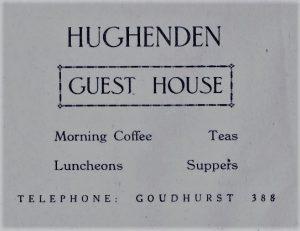 Mrs Hudson sold the business in 1946 and moved to Cranbrook. We do not know who bought the business but the guesthouse and tearoom continued. The Ancient Buildings Trust sold the property to Miss Elsie Beatrice Ellington in 1950 and she continued the tearoom until October 1952 when the property was sold to Miss Gertrude Evans. Miss Evans carried on with the existing business but also added an antique gallery. She apparently put a price tag on all the furniture in her guesthouse and tearooms, which caused much amusement among her guests.
Mrs Hudson sold the business in 1946 and moved to Cranbrook. We do not know who bought the business but the guesthouse and tearoom continued. The Ancient Buildings Trust sold the property to Miss Elsie Beatrice Ellington in 1950 and she continued the tearoom until October 1952 when the property was sold to Miss Gertrude Evans. Miss Evans carried on with the existing business but also added an antique gallery. She apparently put a price tag on all the furniture in her guesthouse and tearooms, which caused much amusement among her guests.
In 1960 Vyvyan Winn and Lorna Stroud purchased the property. They started by serving all meals and accommodation but they soon found they needed to adjust their workload and decided to offer just morning coffee, afternoon teas and overnight accommodation.
Since Lorna sold the property in 1986 it has had a succession of owners. It later became a restaurant but eventually that business closed and the property was sold. After much renovation a dealer in antique clocks and barometers now occupies it.
Car Park and Toilets
Church Rooms
Goudhurst Childrens Play Area
Glebe Field - Village Green
Burial Ground
Lower Glebe
Tattlebury Triangle
Victorian Cemetary
Weavers Cottages
Interesting Building at the end of Back Lane
Blacksmiths and Wheelrights
In the 19th and early 20th centuries a blacksmith and a wheelwright were essential to the everyday life of many folk. The blacksmith produced anything from tools to toys and the wheelwright kept the carts and wagons in good repair. In the 1800s Goudhurst was a predominantly rural community and there were a number of blacksmiths and wheelwrights serving it.
Goudhurst
In the centre of the village stands Forge House. Attached to the side is a single story building that used to be the smithy. Today there are items associated with a forge decoratively arranged in The Old Smithy garden that remind us of its former use. The 1851 census shows that James Bearsby was the blacksmith here. He had come to Goudhurst village from Stone Crouch where his father was a blacksmith. James lived and worked at the Forge until he retired in the late 1800s. Around 1889 David Southon, one of the village butchers, purchased Forge House and the attached workshop from the Ecclesiastical Commissioners. The census for 1901 shows Stephen Crouch living and working here. Following the deaths of David Southon and his son John, Sir Charles Jessel purchased the property in 1907 for Mr Crouch on condition that it remained practically unaltered. Stephen died in 1931 but his wife, Mary, lived on at Forge House until she too died in 1937.
On the opposite side of the Plain in North Road is a house called Rose Villa. In 1841 this was the home of William Usherwood, his wife, Mary, and four of their children. William was a wheelwright and he ran his business from a workshop next to the house. By 1851 only two of their children were still living at Rose Villa, 23 year old Edwin and 20 year old Alfred. Both sons were working as wheelwrights with their father. Ten years later William and Mary were still at Rose Villa. William is shown on the 1861 census as a master wheelwright employing two men. He was 73 years old. By now Edwin had married and was living at Mill Cottages in what was then known as East Road, nowadays called Church Road. He is shown as a wheelwright. His brother Alfred had also married and is shown on the 1861 census living in Stoney Lane with his wife and children. He too is shown as a wheelwright.
However, by 1871 William had died and his son, Alfred, had moved back to Rose Villa and taken over the business. Edwin was still living at Mill Cottages. Then, by the 1881 census Alfred had moved to Sandling in Maidstone and was running his own business as a wheelwright and blacksmith employing three men and one boy. Edwin had now moved back to Rose Villa and was running the business there. Between then and 1891 Edwin’s wife Jane had died and he had married Kate, a widow. He stayed at Rose Villa for a while but by 1901 he had moved to Eastbourne where he died. Ernest Cobb, son of Joseph Cobb the wheelwright at Kilndown, took on the business at Rose Villa for a few years.
In 1908 Stephen Thomas Crouch, known as Tom, who already held the workshop at Forge House on the Plain, also took a lease on Rose Villa. He used the workshop there for a few years but continued to live at Forge House where he died in 1931. Rose Villa itself was occupied by a succession of tenants. The workshop was later used as a garage but was eventually demolished when the site was redeveloped in 2004.
In the 1800s there was a forge at East House on the Cranbrook Road. The deeds, dating back to 1705, show that the plot then was just land and, had no buildings on it. Some years later Isaac Bates owned the land and, in 1813, he made it over to John Waghorn, a blacksmith, and George Hayward, a wheelwright. We do not know whether it was John and George who built the forge and workshop but we do know that Edward Austin acquired the property in 1849 and it is believed that he built the house for himself and his wife, Frances. At the time Edward was a blacksmith and by the time of the 1851 census he was employing one apprentice. However, by the 1861 census Edward and his family had moved out of East House and he was landlord at the Star and Crown in the village. William Hunt is listed in Kelly’s Directories of 1861, 1862 and 1867 as a blacksmith. The 1861 census shows a William Hunt, blacksmith, living in Chequers Road. There is also reference in the Goudhurst Coronation Book, in the reminiscences section, to Horace Blunt working for a Mr Hunt at East House so it is probable that William was running the forge at East House.
In 1869 Dearing Durrant, a butcher from Greenwich, purchased the property for £300. In 1840 he had married Jane Russell, who had been born in Goudhurst, so he had a connection with the village. However, Dearing and Jane continued to live in Greenwich and let East House and the forge. The 1871 census shows Edward Down and his wife Jane living here. Edward is shown as a blacksmith employing one man and one boy. By the time of the1881 census Thomas Burren was living and working at East House forge. He is also listed in the 1874 Kelly’s Directory as a blacksmith in Goudhurst so he was probably working at East House forge then. Thomas bought some land in Beresford Road where he built his own house and forge. He is listed in the 1891 Kelly’s directory as a blacksmith at Swiss Cottage, Beresford Road, so he had moved to his new house and forge by then. In 1888 Dearing Durrant died and two of his daughters inherited East House. They continued to let the property, firstly to Thomas Burren and then, in 1898, to James Thomas Dobell, a carpenter. In 1902 Mr Durrant’s daughters sold East House to Mr Henry Broad, a retired builder, for £225. Mr Broad died in 1915 and Mr Jesse Martin bought the property. Thomas Burren was the last blacksmith to work at the forge. In about 1933, after many years standing derelict, the roof of the workshop finally collapsed.
As mentioned above, Thomas Burren built his own house and forge on a plot of land that he had purchased in Beresford Road. We know, from the entry in Kelly’s Directory of 1891, that he was living there and working as a blacksmith. He was also listed on the 1891 census at this address with his wife and family. By 1899 he had moved out and Alfred Tebbs had moved in. Thomas is said to have retired to Yew Tree Farm with his wife and son, John, a former teacher at Goudhurst. By the 1911 census Thomas, aged 72, and his wife, Selina, were living in the High Street, Cranbrook. Alfred Tebbs was not a blacksmith so the forge was no longer in use. Swiss Cottage and the forge were eventually purchased by the Goudhurst Ladies’ College and became a part of the school. There was a forge near to Yew Tree Farm, but Thomas Burren never used it. It was pulled down in 1904.
In the 1800s there was also a forge in Station Road, Goudhurst. The 1871 census lists Henry Penfold as a blacksmith in ‘Lamberhurst Road near Hope Mill’. It is, therefore, reasonable to assume that Henry was working at Station Road Forge until he returned to his father’s forge in Kilndown. Henry’s son, Richard, was also living nearby in Blue Coats Lane and was working as a blacksmith. He too could have been working at Station Road forge until he returned to the Forge in Kilndown following the death of his father in 1902. The 1881 census also lists William Young as a blacksmith and labourer living in Blue Coats Lane. Maybe he too worked at Station Road forge?
In 1891 Charles Styles is listed on the census as a blacksmith at ‘Hope Mill Forge’. On the census in 1901 and 1911 Charles is listed as a blacksmith and farmer living at Zion Farm with his wife Elizabeth and his daughter Louisa. He is also listed as a blacksmith in Goudhurst in directories printed between 1891 and 1922. In 1911 his son, also Charles, is listed on the census at Forge Cottage as a Prudential Insurance Collector. In the1922 Kelly’s Directory Charles’ daughter Louisa is listed as a shopkeeper at Forge Cottage. Charles’ wife died in 1928 and he moved to Horsmonden in about 1930. He died there just a few years later in 1932. Between 1930 and 1948 Kelly’s Directory shows Arthur Jeffery as blacksmith at The Forge, Station Road.
There was another forge in North Road at the corner of Gore Lane. Horace Blunt worked there for a time around 1899. Horace had moved from Horsmonden to Morebreddis Cottages, Goudhurst at some time between 1861 and 1871 and he stayed there for the greater part of his life. Horace had two sons, Horace and Herbert, who both became blacksmiths like their father. Horace is said to have worked for Mr Hunt at East House forge and from there he went to Colliers Green forge. His sons probably worked with him at Colliers Green and they are said to have been the last smiths to work that forge before it was demolished. When Horace left Colliers Green he took over the forge at Glassenbury and Herbert worked there with him. In 1889 Horace Jnr. married and by 1891 he had moved to Cranbrook. In 1916 Horace Snr. died. Herbert went to work for Stephen Crouch at his forge on The Plain. When Mr Crouch died Herbert continued to work at the forge for G & F Penn Ltd. They were principally builders and undertakers who had moved to the village from Curtisden Green when they took over Mr Crouch’s business premises. They had clearly decided to keep the forge operating too.
Bricklayers
THE BRICKLAYER’S ARMS
Approaching Goudhurst from the west the road climbs a steep hill. Where the road almost levels out is West Road and the first property on the right is The Bricklayers, formerly known as The Bricklayer’s Arms and Edburton House.
The original property on this site is believed to have been built in the 16th century and at that time it was a house not a pub. In the early1840s the owner of the cottage was Thomas Joy, a bricklayer, and in the 1841 census it was referred to as Joy’s Cottage. Thomas’s tenant was William Penfold, also a bricklayer. William lived there with his wife and family. By the time of the 1851 census, William had built two cottages at the back of the original cottage. The family was living in the new part and his wife, Mary Ann was running a “beer shop” in the original part that fronted the road. It is probable that the name “The Bricklayer’s Arms” was derived from William’s occupation.
In 1851 William’s daughter, Emily, married Charles Humphrey. Charles and Emily lived at The Bricklayer’s Arms and Charles continued to run his carrier business from there as well as running the ‘brewhouse’. By 1861 they had five children. William and Mary Ann Penfold, now aged 69 and 67 respectively, were living in one of the cottages behind the pub. Thomas Penfold, a blacksmith, was living in the other cottage with his wife and four children.
The 1871 census shows that William Penfold, now a widower, was still in the cottage and Thomas Penfold had moved to Ightham. Charles and Emily Humphrey were now living in one of the cottages with their six children. Charles was running his carrier business with assistance from their son William aged 12 years. Their daughter Fanny, aged 18 years, was a dressmaker. James Gilbert had taken over the running of the Bricklayer’s Arms and was living there with his wife Mary and two young children. James held “the Brick” (as it became known locally) until 1894 when he moved on to The Duke at Hartley and then to the Railway Hotel where he died in 1911 aged 68 years after a long period of ill health. During his time at Goudhurst James was a well respected individual. He served as Colour Sergeant in the Weald of Kent Rifle Volunteers for twenty five years, retiring in 1894, and was also Captain of the Weald of Kent Fire Brigade.
In 1883 James Gilbert’s daughter, Fanny, had married James Thomas Dann. James had been running a bootmaking business in Goudhurst for many years until 1894 when he took over the Bricklayer’s Arms from his father in law. James Dann made such a success of the business that the brewery offered him a place at the new George Inn at Lamberhurst. He moved there in 1897 and a new landlord had to be found for the Bricklayer’s Arms.
John Sullivan became landlord at the Bricklayer’s Arms in 1897. He had been keen to take over the pub when James Dann left but had been ‘pipped at the post’ by another man. However, the new man was found to be of unsound character and the brewery let him go. The brewery asked John Sullivan if he still wanted the pub and appointed him straight away. John ran the pub for ten years before moving to The Queen’s Head at Hawkhurst where he stayed for six months before returning to live at Goudhurst working as a farm labourer in Horsmonden and then at Crowbourne.
In the Goudhurst Coronation Book John Sullivan recalls that Thomas Fuller took over the Bricklayer’s Arms for a short while after he left. However, the 1911 census shows Tom Head living there with his wife Naomi and daughter Alice. Tom is shown as a ‘Beer House Keeper’ and Naomi and Alice as ‘assisting in the business’. Later that year John Edward Whittle took over as licensee of the premises. The Kelly’s directory of 1913 shows Frederick Thomas as a ‘beer retailer’ in Goudhurst, and then in 1915 it shows him at The Bricklayers Arms.
At the Cranbrook Licencing Sessions in March 1916 the licence for The Bricklayer’s Arms was withdrawn on the grounds of redundancy. The reason stated was; “being only 170 yards from The Vine, and also it was very low-pitched and badly situated for roadside trade by reason of its situation at the top of a very steep hill”.
In June1916 John Whittle enlisted with the Royal Engineers Railway Operating Division giving his home address as The Bricklayer’s Arms, but when he was discharged in November 1917 he went home to Eastbourne.
Little is known about the property after 1916 when The Bricklayer’s Arms closed until 1922 when Charles Hickman advertised in the Kelly’s directory as a grocer there. However, there are no subsequent entries for him. Then, between 1930 and 1939, Gilbert Bernard Fenner is listed in the directory as a grocer at Edburton House. The name of the house and cottages had changed to Edburton House and Edburton Cottages. When Mr Fenner gave up the house and shop he moved to 2 Lidwells Lane where he lived with his second wife Violet until he died in December 1968.
In 1946 Mr F S Harding and his family had moved in to Vine Cottage in the High Street. He had come to Goudhurst to take up the post of shop assistant in the newsagents. A few months later Edburton House and shop was vacant and Mr Harding took it. The trade directory of 1948 shows Mr F S Harding running a general store. When hop-picking time came around, Mrs Harding was advised to put up wire netting around her shop counter, but being a Londoner herself she declined. The following day a hop-picker came into the shop, wrapped his arms around a wheel of cheese that was standing on the counter and beat a hasty retreat. Mrs Harding had the netting in place when the shop opened the following morning.
In 1951 Mr H Tildersley was advertising in the Parish magazine as “Mr Harding’s successor”. Mr Harding had moved to Tunbridge Wells. Mr Tildesley was still advertising in 1953 but we do not know when he ceased trading. In the 1960s the house and shop had been standing empty and was falling into disrepair.
By the start of the 1970s Edward “Ted” McGuire had bought the house. It had been renovated and converted to a fully residential property and by 2000 it was known as The Bricklayers. It is still a private residence today.
West House & Bank House
West House was built in the late 16th century and has since been enlarged. There is a fireback in the drawing room dated 1650.
William Stevens, was the master of the first National School in Goudhurst from about 1816. William also became village postmaster and ran the post office from the front room of a cottage at the National School at Clay Hill. The 1841 census shows him living at Webb’s Cottage, named after its then owner, James Webb. The 1842 tithe apportionment schedule show the property still owned by James Webb and comprising a shop, house and garden with William Stevens in occupation. William subsequently purchased Webb’s Cottage and, when he retired from the school, transferred the post office business there.
When William died in 1858 his son, George Monckton Stevens became postmaster at West House. He lived there with his wife Mary, his sisters Emily and Matilda and their mother Harriett. Harriett is listed on the 1861 census as a ‘bookseller and stationer’ and George is shown as a ‘solicitor’s clerk and postmaster’, Emily was the ‘Postmaster’s assistant’ and Matilda was a ‘milliner and dressmaker”.
By 1871, Matilda had taken a shop in North Road. Her sister Emily and her mother Harriett had moved to the new cottage with her and Emily was assisting in the business there. George and Mary’s son, William Frederick, and his wife, Elizabeth, moved into West House with his parents. When George died in 1878 his daughter, Matilda took over the role of village postmistress at her shop in North Road.
The 1861 and 1871 census had listed the cottage as The Post Office but after Matilda became postmistress at North Road, the 1881 census listed it as West House. The 1881 census showed George’s daughter in law, Elizabeth, running the stationers business at West House while her husband, William, carried on working as a surveyor and attorney. George’s wife Mary died soon after him in1880.
Elizabeth continued to live at West House and carried on as ‘stationer and bookseller’ until her death in 1930 aged 83 years. Before her death the shop had been taken on by C & A Smith & Co. and Mr H Lowther was running the newsagents business with Mrs Stevens. When she died Mr Lowther carried on there until 1935 when Ernest James Ward had taken over as proprietor for the company. When the Westminster Bank moved to new premises on the Plain in 1934 Mr Ward extended the business to include book lending when he moved into the shop premises at Bank House next door. By 1937 the newsagents had also expanded and was selling knitting and rug wools and held a stock of fashion pattern books for women.
In around 2007 the shop at West House was called “Hearts and Flowers”. When it closed West House became a private residence but still retains the old shop window.
BANK HOUSE
Bank House was built in the 1860s by George Monckton Stevens after he had inherited West House from his father, William Stevens, and became Goudhurst’s postmaster. The new building was attached to West House.
One of George’s first tenants was George Eedes, a chemist and druggist, who had previously been living at Gazebo in the High Street with his wife Annie and their first baby, a daughter also named Annie. However, by 1881 George and his growing family had moved to Manor House in the High Street where he remained until he retired to Edenbridge in 1917.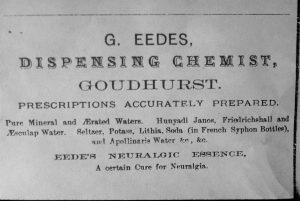
The 1881 census shows the property as unoccupied. Then, in the Goudhurst Coronation Book, there is mention of Jack (John) Hobbs running what was described as ‘a kind of coffee tavern’ there where he sold coffee at a penny a cup. There were two or three adjoining rooms where social evenings were held and people could play bagatelle or listen to readings. Jack was only there for a short while until in the mid 1880s he moved to Church House in the High Street to run a new coffee tavern for Miss Frances Blair.
On 4th April 1902 the Manager of the main branch of the London & County Banking Company in Cranbrook, Mr F E Gilbert, opened a sub branch in Goudhurst. This is when the property became known as Bank House. Mr Gilbert negotiated with Elizabeth Stevens to rent the corner front room of the house, which she had been using for her stationery business. In 1909 the Bank amalgamated with Westminster Bank and changed its name to the London, County and Westminster and then, in 1917, Mr Gilbert retired. Under a new manager the Bank changed its name again to Westminster Bank in 1923. The Westminster Bank was eventually moved to its newly built premises on the Plain in 1934. Following its amalgamation with the National Provincial Bank in 1970, under yet another change of name the National Westminster (NatWest) Bank in Goudhurst finally closed in 1996.
In 1935 C A Smith & Co., newsagents and stationers, extended their business at West House into Bank House and the proprietor, Ernest J Ward, set up a book lending library there. C A Smith was still advertised in the 1940 Kelly’s directory. In 1943 the parish magazine advertises Mr W T Bennett there. Mr F S Harding worked at the newsagents for a few months in 1946 until he took over Mr Fenner’s shop at Edburton House. When Mr F S Harding left, Mr F N Littlefair was running the newsagents. He advertised in the parish magazine in 1948 and 1949 but we do not know when he left.
In 2003 a kitchen design business was opened at the property but the company was dissolved in 2011. Viva Hair and Beauty Salon was established in June 2000 at Rootes Shop next door. Viva opened additional space at Bank House until the salon was eventually transferred there during 2015 and Rootes premises was closed.
The name “Bank House’ was never an official name for the property and it is no longer used. (The official Bank House is in the High Street) The residential flat above the hairdressers is known as The Old Post Office Flat and the business premises are simply addressed as West Road.
Rootes Cottage
Rootes Cottage might possibly date from the 16th century and was, at one time, divided into three dwellings. The earliest owners are unknown but the 1842 tithe apportionment schedule shows Samuel Ford as the owner and occupier. In the early 1800s there is a record of a few former owners and occupiers taken from an indenture, dated 6 April 1857, between John Allwork and Thomas Allwork in connection with the property next door. It showed that the other property benefited from the use of a well in the garden and the owners or occupiers of the other property were required to pay towards the upkeep and repair of the well and its ropes and buckets etc.
The indenture lists ownership of the property (later known as Rootes Cottage) as: “lately belonging to John Lingham, afterwards Samuel Ford, then George Ashenden, then Thomas Wickham…..”
The occupiers were similarly listed as: “late in the occupation of Richard Bellingham, John Golden and Anne Osborne, widow, or some or one or them afterwards Mrs Swatlan, Mrs Martin and Thomas Tolhurst, and then in the occupation of Thomas Haylor.”
In around 1868 the property was purchased by James Johnson from Ninfield and he started a business as a saddler and harness maker. He also built the sweet shop at the front of the property for his sister to use. By 1901 James and his wife and family had moved to Marden and Thomas Goodsell, also a saddler and harness maker, was managing the Goudhurst business for him. Thomas and his family lived in a cottage along the passageway from the cottage. By 1911 Thomas and family had moved to Church Road.
Edward Rootes, grandfather of William ‘Billy’ Rootes of Rootes Group fame, had long been a mechanical engineer in Goudhurst repairing threshing machines and tractors and he had a shed at the top of Balcombes Hill where he kept his workshop. Edward was widowed twice and it was around the time of his marriage to his third wife, Isabella Hicks, in 1897 that he moved to the cottage in West Road. They are shown living at the cottage on the 1901 census. He was to die there after a long illness in 1929. Isabella was running the sweet shop and continued to do so with help from her son, Henry Hicks. When Isabella died in 1942 Henry kept the business going. The last entry for Henry Hicks – confectioner is in the 1948 Kelly’s Directory.
At some time in the early 1900s Father George Mendham purchased the property and an inventory dated March 1935 shows Mrs Edward Rootes paying £11 per half year in rent to him. Father Mendham left Goudhurst that year and then died in Ireland in November 1935.
Adverts appear in Goudhurst parish magazines from the 1960s to the early 1970s listing ‘Rootes General Stores’ here.
Between 1976 and 1981 Rootes Cottage was owned by Michael and Linden Willcocks who had moved to Goudhurst from East Peckham and opened “The Linden Salon” hairdressers in the attached shop.
By 2000 the shop was a hairdressing salon run by Keith Francis. After a few years Viva Hair and Beauty opened. When Viva transferred to Bank House next door a food store opened. Since then the shop has had a variety of owners and functions.
The cottage is now a private residence however the shop still operates and is home to Billie Loves.
Oakley (Oakleigh House)
OAKLEY (OAKLEIGH) HOUSE
The original name for this property was Brickwall. In his book “The History and Topographical Survey of Kent”, published in 1798, Edward Hasted recorded that the Rev. Mr Thomas Bathurst of Finchcocks owned it. Since then the property has been added to and its name has changed more than once.
Notes in the Goudhurst Jubilee Book 1935 tell us that the ‘original occupant’ was a man named Baker who was a rope maker. He lived in a much smaller cottage than that which exists today so it may be that this was one of the farm buildings rather than the main house. Thomas Henry Baker made rope as well as sail cloth, hop pockets and other items between the early 1850s and 1860 when he moved to Tonbridge. His business was in Rope Walk.
Next we are told that the Lake family of Taywell took it on, enlarged it and built a brick wall around it to give the grounds privacy. However, none of them lived to occupy it. Later it became the property of Mr Hussey of Scotney Castle.
In about 1864 Dr. Robert Samuel Newington, son of surgeon Samuel Wilmott Newington of Tattlebury House, returned to Goudhurst with his wife Lucy. Samuel had previously purchased the house and Robert and Lucy moved in there. It was Robert who renamed it Oakley after the house they had lived in in Wales. When his father died in 1868, under the terms of his will, his trustees advertised Oakley for sale together with some plots of land Samuel had owned. Robert moved to Tattlebury House where he carried on his late father’s work.
In the 1870s Lady Nott and her daughter, Miss Rose Caroline Twisden-Hodges, lived at Oakley. In October 1876 the village was decorated for the wedding of Rose to Captain Henry John Peareth.
Then, in 1880, Miss Sophia Dashwood came to Goudhurst and established a school at ‘Oakleigh’. The 1881 census lists all the scholars, aged between 5 and 19 years, as ‘cripples’ . The local press described her as “a kind hearted lady who receives crippled children into her home and has them educated into the tenets of the Catholic faith”. Although she was baptised into the Church of England, Miss Dashwood had later converted to the Catholic faith and she was instrumental in establishing the Roman Catholic Church (the Church of the Most Sacred Heart) in Goudhurst. She had a small wooden chapel erected in the grounds of Oakleigh that was accessed from West Road through a wooden gate in the garden wall. The gate is till there today.
In 1892 Mrs Katharine Sumner Gibson, a widow, came to Goudhurst. She lived at Oakley for 21 years until her death in 1913.
Following Mrs Sumner Gibson’s departure, Major Eric Stockwell bought Oakley. He improved the interior of the house and also had the Lodge built. After the major died in January 1919, Mrs Mary Stockwell married Captain Charles Slater in June 1920. Together they enlarged the property by purchasing additional fields belonging to the Manor Estate.
When Captain and Mrs Slater left Oakley House in 1923, Mr R T jones bought the property. He pulled down some of the old rooms facing West Road and built a small residence in the grounds that he called Oakley Cottage. In the Parish magazine for July 1928 it is recorded that Mr Jones invited members of the Goudhurst Women’s Institute to the gardens of Oakley House and he arranged for the Brass Band to play for them. After a few years together at Oakley Mrs Jones died. In May 1935 Mr Jones moved to Tunbridge Wells and Mr Frank Simmonds, of Manor House in the High Street, bought Oakley and shortly after put it up for sale again.
By 1939 Miss Margaret B Reid had purchased Oakley and opened a boarding and day school there for boys and girls aged 4 to 11 years. The property was renamed Pinehurst and the school took that name too. In 1951 Miss Reid sold the school to Mrs M D Price. Just two years later, in 1953, Mrs Caroline E G Feek took over as Principal at the school and slightly adjusted her terms to take boys aged 5 to 8 years and girls aged 5 to 13 years. After Pinehurst School closed following Mrs Feek’s bankruptcy in 1962, the property was divided and today there are four separate residential properties on the site, Pinehurst, The Knowle, Ainslie Cottage and Pinehurst Cottage.
The Old Firestation/Chequers Garage
THE OLD FIRE STATION
The original fire station and Brigade headquarters was in North Road and housed a manual pump engine. In that same year a new steam powered fire engine had been purchased and on Tuesday 25 August 1874 it finally arrived in Goudhurst, drawn by four horses, amid great pomp and ceremony.
Early in the morning of Wednesday 17 November 1875 a fire broke out in the old engine shed and the wooden building in North Road was completely destroyed. The Brigade members had managed to get the new steam engine out before the fire took hold but alternative premises were now needed to house the engine and to provide headquarters for the brigade members. Before the day of the fire, talks had already been under way to provide a new engine house more suited to the new steam engine and fundraising was now started in earnest. In the meantime Jarvis Lambert, of Yew Tree Cottage in Church Road, looked after the engine.
A suitable site was found at the old Manor Pound adjacent to Oakley House and Mr I T Potter built a new engine-house there at a cost of £120, almost half of which was found from public subscription. On 27 March 1878 the Weald of Kent Fire Brigade took possession of its new premises and the engine was brought from Mr Lambert’s house to the Plain. In 1930 a new engine was purchased and it served the Brigade until a motor engine fire tender was built from an ex RAF fire tender in 1940.
When war was declared in September 1939 a floor was constructed in the roof space of the old fire station to provide sleeping accommodation for brigade members so that they would be immediately available in the event of a fire or other emergency. In 1941 the Brigade was taken over by the National Fire Service and soon after, in early 1942, it was decided that a new fire station was needed. The Ex-Servicemen’s Club agreed that a sectional building could be erected on land that they owned between the club and Mallard’s House at a rent of £2 per year. The new building provided housing for the fire engine as well as comfortable, heated accommodation for the firemen.
1948 saw the end of the National Fire Brigade and fire services in the county were handed over to the Kent County Fire Service. The temporary war time fire station was no longer appropriate and the building was sold to the Ex-servicemen’s Club. A search for alternative land for a permanent station was unsuccessful and so the Goudhurst Fire Brigade was axed.
The firestation became Chequers Garage. In March 1932 Mr C F Trevor was proprietor of Chequers Garage and he regularly advertised his business in the parish magazine. The street directory for 1935 shows that Jesse Apps was living at Plain House with his wife and that he was a motor engineer. Between 1938 and 1940 his listing had changed to show the business as ‘Apps Motors’.
The trade directory of 1948 shows that Mr Chas. Eric Boorman was a motor engineer at Chequers Garage. Then, between 1950 and 1971, George and Joy Waters were running Chequers Garage. Another entry in the parish magazine in 1975 mentions Mr Baldock of Chequers Garage. Mr Baldock is said to have been an ‘avid collector of vintage machines’ and the article tells us that he had recently purchased a bicycle bearing the name of William Rootes of Rootes Group fame.
The building today is home to Goudhurst Legal.
The building featured in a sketch recorded by comedian, Dick Emery filmed one his comedy shows in the 1970’s
Methodist Chapel
Until the 1830s the Methodists in Goudhurst held their meetings in a building, now part of Weeks the bakers. This meeting room measured 18ft by 30ft and with a congregation numbering 76 in 1835 the accommodation must have been quite cramped, so it is perhaps not surprising that plans were then made for a purpose-built chapel.
Thus in 1836, at a cost of £50, a piece of land between Stoney Lane and North Road was purchased and new chapel built and opened in 1837. However, this was not the large brick building seen today on the right as you go down North Road, but merely the small slate-roofed building to the rear of it (demolished in 2011/12). In addition to its use as a Methodist chapel, the small building also served during the daytime as a school run by Miss Betsy Williams.
By 1851 the numbers in the congregation had grown to around 150 and perhaps space was again becoming an issue. However, it was not until 1878 that the large brick chapel was added to the western end of the original small building which it subsequently dominated. The latter then came into use as a Sunday school and, during the Second World War, it was also used as a classroom in which to teach the children who had been evacuated to the village from London.
In 1978 the church celebrated the centenary of the new building. However, numbers in the congregation were already declining as people died or moved away and by the end of the twentieth century had dwindled to 10 members. Such a small number meant that it was no longer viable to keep the chapel going and it finally closed its doors in 2002. The building was sold in 2010 and has now been converted into a private residence.
Mallards House
Mallards House was once the home and shop of a master watch and clock maker and jeweller, Horatio Prickett. Horatio had established his business at his home in Church Road in 1870. After a few years he became tired of the premises at Church Road and in 1877 decided to build himself a new shop and house at The Plain. The house was built by William Apps, the village bricklayer, at a cost of £1000 and was first named Comera House but later to become Plain House. In 1881 Horatio contracted pneumonia “which brought on galloping consumption” and he died on 2 July at only 33 years of age. After his death his brother took over the business for a short while and then the house was sold to Mr Hussey of Scotney Castle.
By 1891 Edward Davis was living in Church Road with his family and is a saddler and harness maker. The 1901 census shows he had moved to The Plain House and is carrying on his business with assistance from his son James. He is also listed in the trade directories between 1891 and 1903. In 1913 his trade listing is expanded to read ‘Edward Davis & Sons, saddlers & harness makers, jobmasters, general carriers, coal merchants, furniture removers, motor car proprietors & agents for the S.E. & C. Railway and Sutton & Co.’ . In 1914 the advert is back to simpler terms but ‘E Davis and Sons, fly proprietors, etc.’ is added as a second listing. The last trade entry is in 1916 when only the ‘saddler and harness makers’ listing appears. Having lived in Goudhurst for 32 years Mr Davis died in 1920. His wife died just under a year later. They are both buried at Frinsted.
An article in the Goudhurst Jubilee Book 1935 tells us that during WW1 Edward Jarvis came to Goudhurst with his family when the house adjoining his in London was blown up. He worked as a saddler and harness maker at Plain House. He advertised his business in the Kelly’s trade directory of 1922 and, in 1928, he advertised in the parish magazine. There is no indication how long he stayed at Plain House but, by 1932, a motor garage had been established there.
In March 1932 Mr C F Trevor was proprietor of Chequers Garage and he regularly advertised his business in the parish magazine. The street directory for 1935 shows that Jesse Apps was living at Plain House with his wife and that he was a motor engineer. Between 1938 and 1940 his listing had changed to show the business as ‘Apps Motors’.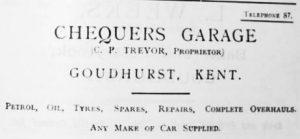
The trade directory of 1948 shows that Mr Chas. Eric Boorman was a motor engineer at Chequers Garage. Then, between 1950 and 1971, George and Joy Waters were running Chequers Garage. Another entry in the parish magazine in 1975 mentions Mr Baldock of Chequers Garage. Mr Baldock is said to have been an ‘avid collector of vintage machines’ and the article tells us that he had recently purchased a bicycle bearing the name of William Rootes of Rootes Group fame.
The garage business finally closed and, until the end of 2017, the premises were the offices of an estate agency. The name was also changed to Mallards House. In January 2018 the property became offices of a wealth management company.
Old Petrol Station - Chequers Garage
To its’ left is the Old Fire Station where comedian, Dick Emery filmed one his comedy shows in the 1970’s
Site of Goudhurst Windmill
Sometimes known as Town Mill, Goudhurst windmill stood behind Weavers’ Cottages in Church Road. It towered above the cottages and from the top the view of the surrounding countryside was said to be better than the view from St Mary’s Church tower. The entrance to the mill was between Mill House and Mill Cottages.
Goudhurst windmill was a Smock Mill. It was a white weatherboard structure on a brick base with a black cap on top where the sweeps, or sails, were fitted. As with the Tower Mill, only the cap on the Smock Mill needed to be turned to the direction of the wind and so make the sweeps turn and drive the shaft. The shaft turned the cogs that turned the millstones. I won’t go into the detailed workings of a windmill, suffice it to say that, in this case, the shaft was made of metal, not wood.
Our archives show that at one time there was a pig pound below the windmill. It is recorded that ..“a lad’s hat blew off while he was descending from the windmill one day and it landed in the pig pound“. Needless to say, the hat was in a real mess! It is also recorded that there were cattle grazing below the mill. How things change!
Goudhurst mill was built in 1803 for a man named Jeremiah Birch. It was constructed by a local reputable millwright by the name of Mr James Humphrey who had his shop and house in Cranbrook where the School Lodge is now. He went on to build windmills at Hythe and Sheerness, and he also built the 70ft high mill which still stands in Cranbrook today, a testament to his skill.
As you can imagine, building a windmill was not without risk to the workmen. During the construction of Goudhurst mill there was a terrible accident. A young apprentice to Mr Humphrey, a lad from Pevensey in his early 20s, fell and broke both legs, both thighs and both arms. We don’t know have any details of his name, how he fell, nor of what happened to him after the accident.
The mill was working for over 70 years and during that time there was a series of millers. In more prosperous times a bakery business was also carried on at the mill. According to old business directories, Henry Allen held the mill until 1839 then John Pope from 1840. However, the tithe map of 1842 shows Henry Allen as the miller and Douglas Moodie as the owner. The land is described as “a hop garden, house and garden, mill, mead and yard“. We believe that Douglas Moodie was the son-in-law of James Humphrey, having married Mr Humphrey’s daughter, Ann in 1830. He was a successful draper with premises in Week Street, Maidstone. Douglas died in 1847 and the mill and land passed to his widow Ann.
The 1841 census shows Henry Allen as the miller with John Pope. Only John Pope appears on a census in 1851 when he is shown as employing 2 men. Dates are overlapping so we can only say that Henry Allen was at the mill until some time between 1839 and 1851. The mill was sold by auction in Maidstone in January 1852. The purchaser was John Miles. In around 1853 John Pope and John Miles formed a partnership. John Miles borrowed £800.00 from William Burgess that year as a mortgage on the mill and land. John Pope is listed in the business directory of 1858 so he was still there then. However, things seem to have gone wrong for them because the partnership was dissolved in 1860.
The mill then came into the hands of one Joseph Norrington. Joseph first appears on the census in 1861. He worked the mill first by himself and then with his son until about 1875. Both father and son are on the1871 census and Joseph, the son, is shown as a miller and baker. The 1871 and 1874 business directories both show Joseph Norrington as the miller. Finally, a Mr Thompson was the last miller. He worked the mill for about 2 years. But, business was declining and the mill became derelict and unsafe. The 1881 census shows the mill as “empty“. Another miller mentioned in the records is Alfred Coleman. It is recorded that he worked the mill for several years but no dates are given.
When the mill fell into disuse it was purchased by Mr Haskett Smith. He had the sweeps removed and a lead roof and railings fitted around the top of the mill to “preserve a most admirable viewpoint, superior in some aspects to the Church Tower”.
After it was closed down, the mill was purchased for demolition by Messrs W Arnold & Sons of Bartley Mill in Frant. It was finally pulled down and dismantled in 1890. The method of raising the mill was quite simple – A wire rope was placed round the structure and fixed to an engine. The engine pulled until the mill fell over. The crash when it fell was apparently heard all over the village.
The iron shaft and some other parts from the dismantled mill were purchased by Mr George Jarvis, a carpenter and wheelwright with works at Bethersden, and used in his sawmill there. Mr Jarvis repaired windmills but, as the use of the traditional Kentish windmills declined, he built up a reputation for his work in demolishing them. He dismantled so many he earned the nickname the “Mill Smasher”
Unfortunately, only one photograph of the mill survives and that shows it standing behind Weavers Cottages.
Weavers Cottages
Village Life
In the 1850s there were three cottages on this site. Edwin Lindridge, who in 1851 had been living at Vine Cottage in North Road, purchased the cottages at some time during the 1850s from savings he had set aside from his earnings as a sawyer. Edwin started his grocers and drapers business from a room at the front of the first of the cottages and let the rest of the cottages until he needed more space for his business and to accommodate his growing family. Gradually all three cottages were incorporated into a house and shop.
In 1852 Edwin had married Sarah Beeching, daughter of Samuel Beeching the baker in the High Street. On the 1861 census Edwin and Sarah are shown living in North Road with their children: Samuel aged 7, Catherine aged 5 and Frank aged 2. Edwin was a Methodist preacher and became Superintendent of the Sunday School at the Wesleyan Chapel in North Road. Miss Elizabeth (Betsy) Williams, a teacher and Methodist, lodged in a room above the shop. She held her Infant School classes in her room until an alternative room was made available to her at the Methodist Chapel in North Road.
In 1888 Edwin and Sarah Lindridge retired to Tunbridge Wells and John Laing Humphries took over the premises. Their sons, Samuel and Frank, both went on to run grocery businesses of their own. Edwin died in 1905 and Sarah in 1914.
In 1881 John Laing Humphries lived with his wife and young son, Lewis, in Brighton. He is shown on the census as a draper and tobacconist. In 1888 John bought Mr Lindridge’s shop and moved to Goudhurst with his family. He now had a second son, Ernest. In the early 1900s Mr Humphries expanded the business by opening a furniture store in the lower of the three cottages. Mrs Humphries ran that shop while Mr Humphries carried on in his business as a grocer and draper and, in 1914, he took his son Ernest into partnership with him.
John Laing Humphries died in 1920 and Ernest carried on running the business until 1928 when he too died aged only 42 years. Mrs Alice Humphries, Ernest’s widow, continued to run the grocery business for a while until, in 1945, Louis Weeks and Albert Brown, of Weeks Bakery in the High Street, took it over and the shop changed its name to Weeks and Brown. The furniture store was last advertised in the Parish Magazine in October 1936 suggesting that Alice closed that side of the business. The two cottages next to the shop are now one private house. More recently the grocers shop has become a clothing and gift shop - Village life continues to thrive.
Rosa Villa
In 1841 this was the home of William Usherwood. William was a wheelwright and he ran his business in a workshop next to the house. However, in 1867 William died and his son, Alfred, took over the business. By 1881 Edwin, another of William’s sons, was running the business. Then, by 1901 Ernest Cobb, son of Joseph Cobb the wheelwright at Kilndown, took on the business at Rose Villa for a few years.
In 1908 Stephen Crouch, who already held the workshop at Forge House on the Plain, also took the lease on Rose Villa. He used the workshop there for a few years but continued to live at Forge House where he died in 1931. Rose Villa itself was occupied by a succession of tenants. The workshop was used as a builders yard and premises by G & F Penn Ltd. from around 1930. Their advertisement in the parish magazine in August 1930 showed them as ‘Builders, Decorators, Sanitary Engineers and Undertakers’. The company was primarily based in Pembury but had also been trading from Curtisden Green before coming to Goudhurst. In 1979 the company went into liquidation and was finally dissolved in 1985. The workshop at Rose Villa was later used as a garage run by Mr Kemp but was eventually demolished when the site was redeveloped in 2004.
Old Parsonage Surgery
A modern low rise building off Balcombes Hill. https://www.oldparsonagesurgery.nhs.uk
Much of the content relies on information from the The Goudhurst & Kilndown Local History Society

